RBA Annual Conference – 1990 The Labour Market Bruce Chapman[*]
1. Introduction
Both the Australian labour market and the Australian labour market debate changed dramatically over the 1980s. For the former, unemployment reached its highest level in 50 years in 1983, which was followed by arguably the first sustained decrease in joblessness since the late 1930s. The extraordinary job expansion of 1984–89 has been accompanied by (the highly unusual experience of) cuts in real wages, unprecedented participation levels, a clear diminution of hidden unemployment and an apparent aggregate slow-down in labour productivity growth. More clearly on the darker side, long term unemployment nearly tripled from 1982 to 1984, and remained stubbornly high to the end of the decade.
These unfamiliar occurrences have been accompanied by a perceptible change in the nature of the debate. The ‘real wage overhang’ argument of the 1970s has all but disappeared with the overhang itself, the debating points probably not going to either of the extreme positions. As well, there is an emerging consensus that, at least in the Australian institutional environment, an incomes policy has the potential to deliver propitious aggregate, but not necessarily microeconomic, labour market outcomes. These and other issues are the subject of what follows.
It is important to consider whether or not the Australian 1980s outcomes were driven by, or at least shared with, other OECD economies. There is little point analysing in great depth allegedly domestic influences if these seem to be dominated by international forces. It follows that some examination of the relationship between Australian and OECD labour market experience is warranted, and is undertaken in Section 2. The story seems to be that in important ways the Australian labour market has behaved similarly to those of other countries, but some interesting differences exist, perhaps most clearly in the 1980s.
Section 3 explores the relationships between labour force participation, employment, unemployment and long-term unemployment. Recent evidence is used to examine the (apparently causal) links between the growth in labour demand and changes in labour supply. This link suggests that participation rates are strongly pro-cyclical, which necessarily implies two things: that measures of unemployment are incorrect and that the extent of the measurement problem is positively correlated with increases in joblessness. The data are adjusted to illustrate the potential importance of this issue. As well, a simple empirical investigation is undertaken of the role of long-term unemployment for job mismatching, in the context of the unemployment-vacancies relationship.
Section 4 examines the role of wages as a determinant of labour demand. The real wage overhang debate is critically appraised, and some allusions are made to the possible role of both wage inflation and changes in real wages for investment and employment. It is argued that compelling empirical evidence exists for the proposition that labour costs – levels and changes – influence employment growth, but not primarily (at least in the short run) because of capital/labour substitution.
Section 5, probably the major contribution of the exercise, is an analysis of the role of institutional factors in influencing aggregate wage outcomes. There is little doubt that the Prices and Incomes Accord was initiated in response to a perceived need to restrain wage growth, and possibly even to increase significantly the profit share. Recently theoretical developments have promoted the role of countries' wage-setting institutional arrangements as being fundamental to labour cost outcomes, a proposition that is testable in the time series context in Australia. The results of the experiment are presented for a variety of models. As well in this section, a brief examination is offered of criticism of the Accord which includes a reporting of labour productivity growth econometric estimates.
The theoretical and empirical material of Sections 3 to 5 may be linked conceptually, an exercise carried out in a final main section. Here it is argued that a structural change in wage outcomes after the beginning of 1983 influenced the non-accelerating inflation rate of unemployment (NAIRU), which was associated with increases in employment and labour supply, and decreases in labour productivity growth, the unemployment rate and the number of long-term unemployed. Counter-factual data are presented to illustrate what the Australian labour market might have looked like at the end of 1989 if wage outcomes different to those actually experienced in 1983–89 had occurred. The experiments suggest that institutional arrangements in wage-setting are fundamental to labour costs, and thus employment, which in turn affects labour productivity growth, labour supply, unemployment and long-term unemployment.
It is important to establish at the outset what the paper is, and is not, about. One goal is to document descriptively the basic empirical aggregates, hopefully in ways that elucidate the underlying theoretical and policy issues. Ultimately, however, the paper is not concerned with questions of theory. Theory always matters with respect to an understanding of what data mean, and how policy might be assessed and understood, but comprehending the subtleties of particular modelling perspectives is not a goal in the exercise.
The decisions of what not to cover have been made on the basis of whether or not the issues are of obvious empirical importance for the operation of the aggregate labour market. This means that questions concerning the implications of Australian institutional arrangements for employer-employee relationships, and how these may have changed over the 1980s, are not addressed. Consequently, it follows that both in subject matter and in terms of providing a comprehensive framework for assessment of labour market policy more remains to be done.
The above is true also for some of the major aggregates, an example being that of age breakdowns. The teenage labour market, and the labour market of the aged are not, empirically, substantial matters for consideration of the overall workings of the Australian economy. Less than 15 per cent of the labour force (in 1989) was younger than 20 years or older than 60 years of age. This is not to deny that important and interesting issues arise in consideration of these groups, and these include the substantial increases in school retention rates over the 1980s, trend decreases in older male participation, and the considerably different unemployment durations for young and old people compared to the rest.
As well, no discussion is offered on the potential for changes in unemployment benefits to affect the level of unemployment, the judgement being that while this relationship exists in theory, empirical estimates suggest that its size is small.[1] Finally, while there were significant changes in the industrial composition of employment over the 1980s, understanding fully the relevance of this for aggregate outcomes is not a major preoccupation. However in some areas – notably labour productivity growth – some allusions to disaggregations are required and are undertaken.
In short, the paper has a big picture orientation. It seeks to explore the major labour market aggregates in the 1980s, and to assess what has brought about the changes. An important theme is that comprehending the nature and force of institutional influences is fundamental to an understanding of what labour markets can deliver.
2. The Australian Labour Market in International Context
(a) Introduction
It would be naive and inaccurate to characterise the Australian economy generally as operating as if in a vacuum: clearly it is subjected to and influenced by the various ebbs and flows of international economic forces (McLean (1989)). It is quite likely also that changes in labour aggregates reflect the influence of both world-wide events and shared policy perspectives, it thus being hard to be confident that stories told about the Australian labour market are novel. An analysis of the dynamics of the Australian labour market in an international comparative context is a substantial research project,[2] and well beyond the boundaries of this paper, but some indications of the extent of shared experience warrant attention. Empirical comparisons are offered below, but before this is done it might be useful to consider as background some of the more important conceptual issues.
(b) Conceptual Issues
There are three possible outcomes arising from a comparison of Australian labour market experience with that of the rest of the OECD. Case A is that they are identical; Case B is that they are completely different; and Case C is that they are neither the same nor disparate, a mixed bag. For policy analysis it matters which of these is true.
Case A: In the situation of Australia experiencing both the same directions and empirical magnitudes of changes in its labour market as occurs in the rest of the OECD, at least two possibilities arise. The first is that institutional change or policy differences exist, but they have no consequences for labour market outcomes. A second is that institutions or policy do have real effects, but Australian variations in these areas have followed closely those of the rest of the OECD. In the situation of Case A it needs to be determined why there is common ground, and it should be acknowledged that the separate role of domestic influences is unclear.
Case B: The situation is more straightforward if the dynamics of the Australian labour market show no systematic relationship to those of other OECD countries. A priori this would seem to imply that institutional and policy approaches are both idiosyncratic and influential. It follows that examination of the domestic environment without detailed reference to other countries' labour markets is valid and useful per se for the Australian debate.
Case C: The most likely result of a comparison between Australia and the OECD is that some outcomes are similar, and some are different. In this case caution is needed in an assessment of the separate roles of shared outside forces and exceptional local responses. Ideally in this circumstance an attempt would be made to isolate the relative empirical magnitudes and significance of both institutions and policy peculiar to Australia, from the underlying economic experience shared with the OECD.
The bottom line is that it would be incautious to proceed without paying some attention to the relationship between Australian labour market outcomes and those of other countries. Knowing which of A, B and C is apparently the case helps, but does not necessarily resolve unambiguously the question of the usefulness of the subsequent concentration on the domestic scene. It does, however, provide indications of those areas in which more, or less, concern lies with interpretation of institutional and policy influences.
(c) Some Empirical Comparisons
The labour market comprises a network of highly inter-related forces, most of which are measured poorly or not at all. Given this, a challenge always is to find adequate data to reflect underlying relationships. For the international comparison exercise three variables have been chosen to represent the broad sweep of aggregate labour market experience over the last 25 years: the employment to population ratio, interpreted as a rough indicator of job provision; real hourly earnings in manufacturing, a proxy for both labour incomes and costs; and the share of GDP distributed to wage and salary earners, to represent bargaining outcomes, the influence of the business cycle and underlying changes in labour productivity growth. The choice has been motivated by data availability and the breadth of the evidence as overall proxies of activity and distribution.
Figure 1 illustrates the Australian and the (unweighted) OECD average with respect to employment/population ratios (E/P). These are better data to indicate the job situation than unemployment rates, for example, because of the considerable measurement problems associated with the latter, an issue taken up in Section 3.
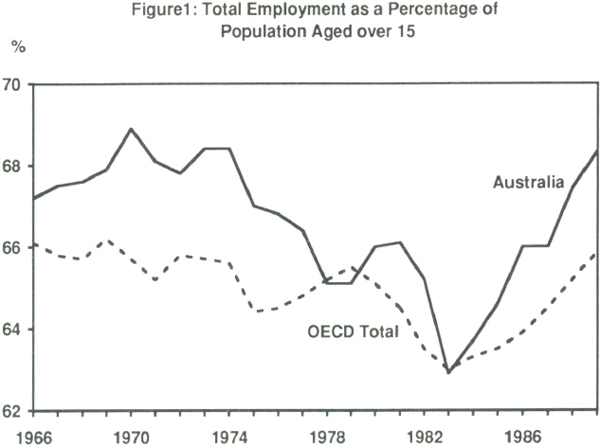
From Figure 1 it is clear that the Australian E/P trends are not dissimilar to those of the (unweighted) average of the OECD. However, the Australian decrease from 1966 to 1983 is relatively rapid,[3] and the increase from 1983 is considerably higher. Australian E/P experience is neither identical to nor markedly different from the OECD, except that the early decline and the later recovery were relatively rapid.
Figure 2 illustrates rates of changes in real manufacturing hourly earnings.
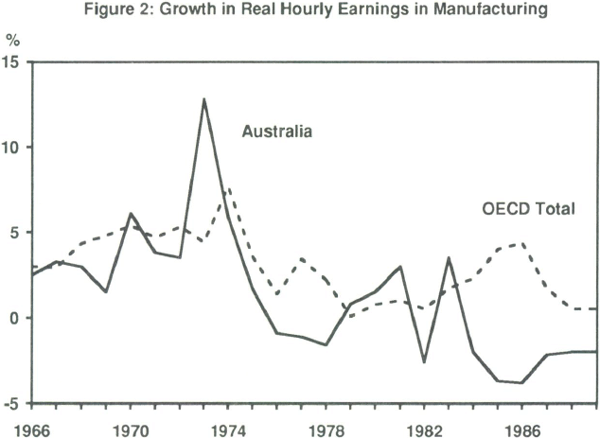
As with E/P, Australian real hourly earnings in manufacturing moved approximately with those of the OECD total (with the marked exception of 1974) for the 1966–76 period. However, differences then started to emerge which become striking after 1982.
Different to the above, and of considerable interest for the policy discussion, are the data concerning the proportion of GDP going to wage and salary earners, presented now in Figure 3.
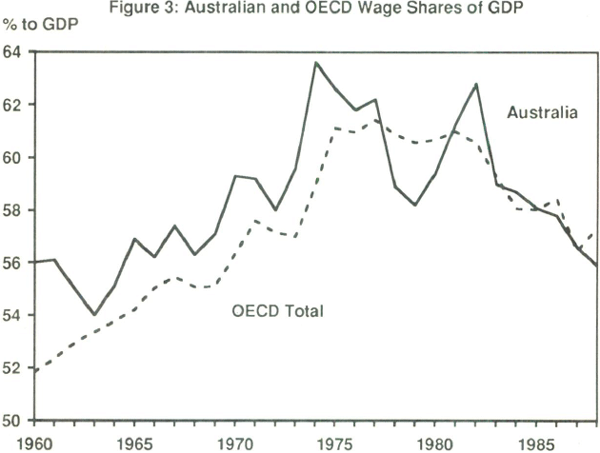
The data in Figure 3 show that the Australian (wage and salary) factor share followed a course that was very similar to the (unweighted) average of the rest of the OECD, until about 1976. After that, late 1970s decreases and early 1980s increases were relatively large. The marked similarity after 1982 promotes important questions concerning both the relative empirical contribution of real wage and labour productivity changes in international comparisons, and the more complicated issue of whether or not there have emerged internationally shared perspectives on the appropriate distribution of the economic cake. Some of these concerns are addressed in Section 5.
(d) Conclusion
The nature of an investigation into the aggregate Australian labour market over the 1980s depends in part on how much of this experience is common to other OECD countries. It is more justified to accentuate the role of domestic institutional forces and policies if Australian labour market outcomes are apparently quite unusual than if this is not the case. In this section Australian employment to population ratios, changes in manufacturing real hourly earnings and factor shares in GDP have been compared to (unweighted) averages of total OECD outcomes.
While the average across the OECD for these variables is not an ideal measuring stick since, for example, quite disparate countries could be cancelling each other out, some useful indications arise. They are that Australia is neither uniquely different to nor the same as the OECD as a whole. Importantly for the analysis following, the Australian real wages and employment experience is a bit different, and factor shares are very similar to the rest of the OECD.
Of some interest for the rest of the exercise, it is relatively difficult to support the proposition that the Australian labour market in the 1980s looked the same as the average of the OECD, particularly concerning real wages and employment which relatively decreased and increased respectively. Direct statistical tests have not been offered, but a reasonable case exists for analysing the domestic labour market relationships in this period without specific attention being paid to details of OECD experience. Ultimately, however, it is highly likely that further international comparisons would be very useful especially with respect to the similarities uncovered concerning factor shares, an issue considered more in Section 5.
3. Labour Force Participation, Jobs, Unemployment and Long-Term Unemployment
(a) Introduction
The most commonly used aggregate measure of the state of the labour market is the unemployment rate, or the proportion of the labour force identified as being jobless. From Figure 4 it is clear that over the 1980s the Australian unemployment rate went through some considerable changes: it increased dramatically from 6.2 per cent at the turn of the decade to around 10 per cent in 1983, and fell in a sustained fashion over the following six years to reach 5.9 per cent in 1989.
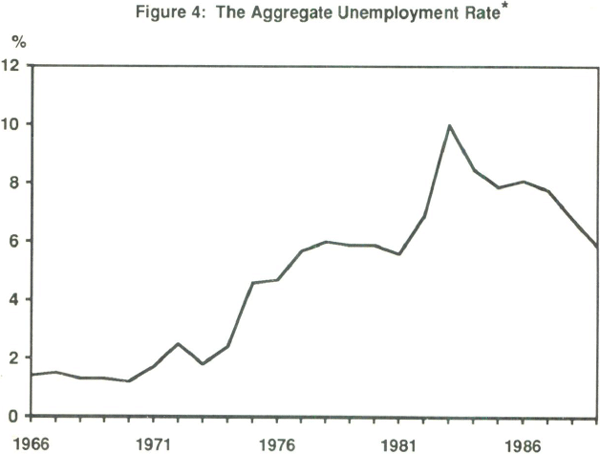
* Data in Figures 4, 5, 6, 7, 8, 9, 10, 11, 12, 13, 14, 15, 16, 17, 20, 21, and 22 are plotted as at August each year.
These data matter because less-than-full utilisation of the available labour force implies output loss, both in the short-run when producing inside the production possibility frontier, and in the long run due to losses of human capital through skill atrophy and negative impacts on the rate of accumulation of physical capital. Moreover, unemployment is usually associated with movements to less equal income distributions and opportunities. These costs are probably particularly acute when individuals experience prolonged spells of involuntary joblessness. Unemployment in general, and long-term unemployment in particular, are issues of considerable policy relevance.
As a summary guide to joblessness, in both theoretical and measurement terms the unemployment rate disguises much of interest. Among other things this section describes and explains the various influences on the measure typically used. Two clear messages are that it should be used with circumspection, and that important understandings arise from analysis of the components that go to make up the unemployment rate.
(b) The Role of Labour Supply and Hidden Unemployment
To illustrate the importance of labour supply as an influence on the unemployment rate it is useful to consider the following identity:
where U is the number of unemployed persons, LF is the size of the labour force and J is the number of persons in jobs. Equation (1) can be manipulated to define the unemployment rate (UR):
It follows from (1) and (2) that unemployment measures are influenced both by the number of people in jobs and the size of the labour force. Using the available unemployment data as a measure of joblessness would be a matter of slight concern only if the labour force was constant or was changing in a way unrelated to the number of jobs. It thus matters to determine whether or not this is the case.
The total labour supply is given usually by the number of persons aged greater than 15 who choose to participate in the labour market. The first of these is influenced by two things: the (size and age) composition of both the Australian-born and immigrant populations aged greater than 15. From Figure 5 it seems to be the case that neither of these variables is subject to profound shifts, but it should be noted that the rate of net immigration has tended to fall when the economy is in recession.[4]
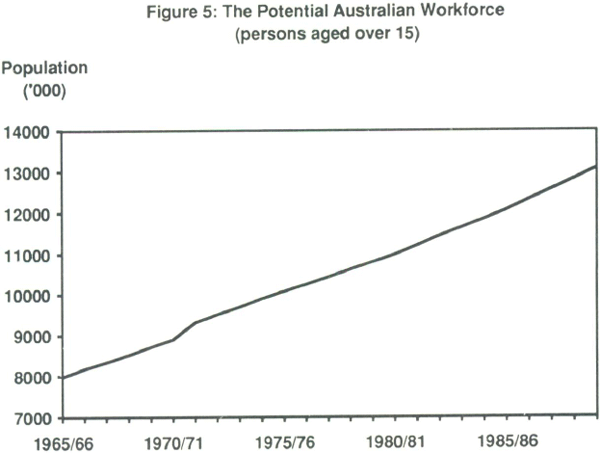
Given that the potential labour force does not obviously vary substantially, concern with the role of labour supply as an influence on unemployment is more properly focused on the so-called labour force participation rate, which is the proportion of the population aged more than 15 which is in the labour force. Figures 6 and 7 illustrate its level for males and females in the 1966–89 period.
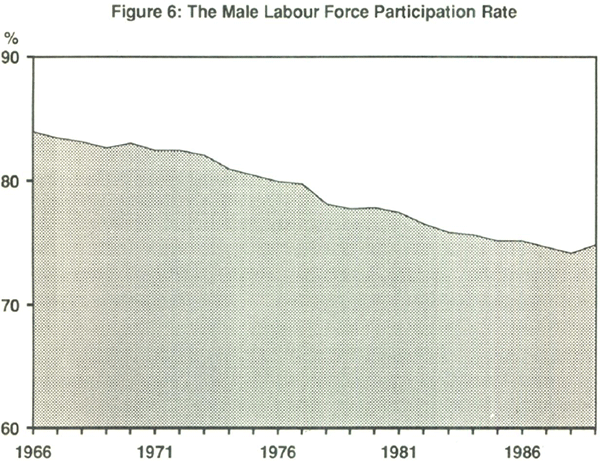
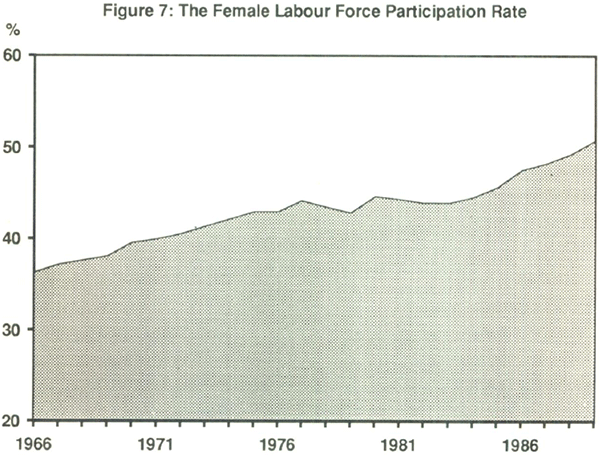
Clear differences exist between male and female participation rate trends, with the former showing a consistent decline over the last quarter of a century, and the latter doing the opposite. While there is much of interest behind these phenomena, in an examination of the links from labour supply to the aggregate unemployment rate it is more pertinent to focus on the total participation rate. Its rate of change is shown in Figure 8, which allows also a comparison with job growth for reasons that will become clear below.
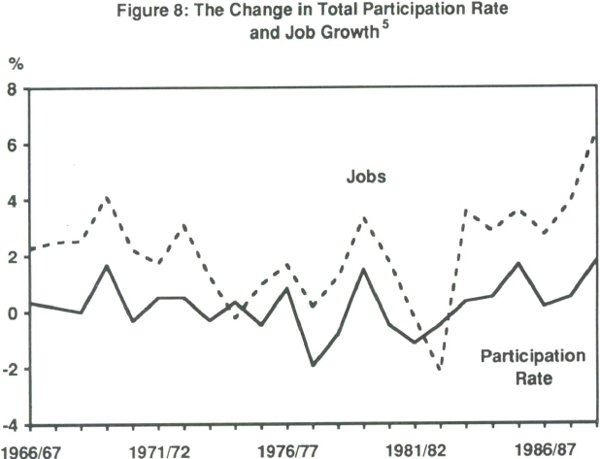
From Figure 8 it is apparently the case that, except in 1974–75,[5] the change in the participation rate is positively associated with job growth. That is, as the labour market moves into recession a smaller proportion of potential workers search for jobs, a phenomenon known as ‘hidden unemployment’. In theory there is a counter-balancing factor known as the ‘additional worker effect’, in which higher unemployment might lead to greater participation as persons previously not in the labour force search for jobs to make up for the decreases in household income from the job loss of other family members. Australian econometric analysis (Dowrick (1988)) supports strongly the impression from Figure 8, that hidden unemployment effects influence markedly changes in the participation rate, which is another way of saying that (measured) labour supply is endogenous to labour demand. The econometric evidence is explored in Section 6.
In order to understand the empirical significance of these phenomena, it is useful to consider in aggregate the relationship between the number of jobs and the size of the labour force (Figure 9), an exercise which has prompted some (very crude) estimates to be made of the extent of hidden unemployment.[6] This exploration makes it possible to adjust the unemployment rate so that it more truly reflects the underlying joblessness in Australia in the 1966–89 period. Whilst of interest in itself the step allows also some insights into the relevance of job mismatch for the efficiency of the operation of the labour market.
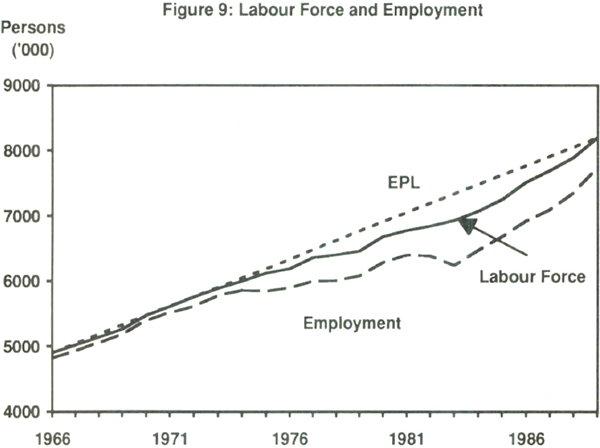
As was apparently the case from Figure 8, the data of Figure 9 suggest that after the mid-1970s the rate of increase of labour force participation slowed in response to the diminution in job growth, and increased notably after 1983 as employment growth became strong. Given an experiment assuming that hidden unemployment was zero at the end points of 1966 and 1989,[7] assumptions chosen because of the very low unemployment rate in 1966 and the record participation rates in 1989, the dotted line EPL (estimated potential labour) is a representation of what the labour force might have been without the (presumed) cyclical response of participation.
It follows that by deriving the equation of EPL, it is possible to gain an impression of the potential labour force in the absence of the presumed cyclical response of participation, and from there derive estimates of hidden unemployment. This allows an adjustment of the measured unemployment rate to incorporate those persons who would have been included as unemployed if they had believed that active searching for jobs would have resulted in favourable outcomes. The relevant data from this exercise are summarised in Table 1, and the measured and adjusted unemployment rates are illustrated in Figure 10.
| Year | Measured Unemployment ('000s) |
Estimated Hidden Unemployment ('000s) | Estimated Unemployment ('000s) |
Measured Unemployment Rate (%) (August) | Estimated Unemployment Rate (%) |
|---|---|---|---|---|---|
| 1966 | 78.6 | 0.0 | 78.6 | 1.8 | 1.8 |
| 1967 | 86.8 | 25.9 | 112.7 | 1.7 | 2.5 |
| 1968 | 81.2 | 52.2 | 133.4 | 1.6 | 2.6 |
| 1969 | 78.9 | 70.3 | 149.2 | 1.5 | 2.8 |
| 1970 | 78.2 | 1.7 | 79.9 | 1.4 | 1.5 |
| 1971 | 92.7 | 10.3 | 103.0 | 1.7 | 1.8 |
| 1972 | 144.0 | 8.0 | 152.0 | 2.5 | 2.6 |
| 1973 | 105.7 | 16.5 | 122.2 | 1.8 | 2.0 |
| 1974 | 140.9 | 52.3 | 193.2 | 2.4 | 3.2 |
| 1975 | 278.4 | 72.0 | 350.4 | 4.6 | 5.7 |
| 1976 | 292.7 | 144.4 | 437.1 | 4.7 | 7.0 |
| 1977 | 359.3 | 123.4 | 482.7 | 5.7 | 7.6 |
| 1978 | 398.6 | 218.2 | 616.8 | 6.2 | 9.6 |
| 1979 | 377.5 | 308.6 | 686.1 | 5.9 | 10.6 |
| 1980 | 394.5 | 232.0 | 626.5 | 5.9 | 9.4 |
| 1981 | 380.6 | 276.8 | 657.4 | 5.6 | 9.7 |
| 1982 | 461.4 | 353.6 | 815.0 | 6.7 | 11.9 |
| 1983 | 686.8 | 409.7 | 1,096.5 | 10.0 | 15.8 |
| 1984 | 604.0 | 410.7 | 1,014.7 | 8.6 | 14.4 |
| 1985 | 572.7 | 375.7 | 948.5 | 7.9 | 13.0 |
| 1986 | 597.6 | 251.1 | 848.7 | 8.0 | 11.3 |
| 1987 | 602.1 | 216.1 | 818.2 | 7.8 | 10.6 |
| 1988 | 538.7 | 161.7 | 700.4 | 7.1 | 8.9 |
| 1989 | 469.4 | 0.0 | 469.4 | 5.9 | 5.9 |
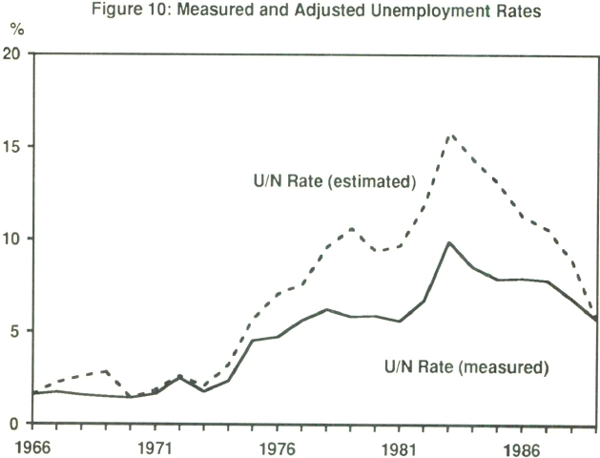
These exercises imply clearly that hidden unemployment exists, and that it is apparently empirically important. In the 1980s the measurement concerns, and the policy judgements conditional on the data, were more significant than for the previous 40 years. Of relevance to this point, from Table 1 it is probably true that as the measured unemployment rate increased, it systematically understated the joblessness situation.
From this brief exploration of unemployment rates, labour force participation and hidden unemployment, several points are worth making. First, while Australian unemployment rates in the 1980s were on average very high, the measured situation relative to the 1960s and early 1970s apparently under-represents the deterioration of the labour market. What appears to be a large increase in joblessness can reasonably be interpreted as being much more severe than examination of the usual data suggests.[8]
Secondly, the improvement in the aggregate labour market since 1984 is probably much more substantial than is apparently the case from observations of the change in the measured unemployment rate. The revised estimates of the unemployment rate imply that the decrease to a 1989 rate of about 6 per cent may have been from a base in 1983 of nearly 16 per cent, not the measured 10 per cent. This is because the data usually reported do not reflect the cyclical response of participation, which seems to imply (Gregory (1989), Dowrick (1988)) that an extra 1 percentage point in job growth increases participation on average by around 0.4 percentage points. Measured labour supply is endogenous to job growth, and the effect is apparently not trivial.
Thirdly, because of the continual growth of the population aged greater than 15 – of slightly less than 2.0 per cent a year – considerable job expansion is required to lower the unemployment rate quickly, a challenge highlighted in Chapman, Dowrick and Junankar (1989). In that exercise it is noted that while employment growth averaged 3.62 per cent per year from 1983–89, the measured unemployment rate fell on average by only 0.66 percentage points a year. The revised unemployment rate data suggest that this latter number could have been as high as 1.56 percentage points per year if there had been no participation-rate response to the job growth.
Finally, these exercises imply something quite interesting, albeit poorly defined, for policy. This is that over the period 1966–89, if the two financial years – 1974/75 and 1982/83 – had had the average employment growth of all the other years instead of what actually occurred, and if nothing else had changed the (measured) unemployment rate in 1989 would have been about 2 per cent, instead of around 6 per cent. This observation is made to highlight the importance of how significant just a few poor employment growth years are as influences on medium-term unemployment outcomes. That is, when job growth stagnates it has profound (and long-lasting) effects.
Among other things, the above means that the reported unemployment rate is a poor, and systematically biased, measure of joblessness. The important point is that interpretation of labour market improvement or deterioration on the basis of the usual official data uniformly distorts the underlying reality, so long as the participation rate responds to the state of the labour market.[9] The bottom line is that over the 1980s both the levels and changes in the utilisation of labour are even more extraordinary than first appears.
(c) The Composition of Jobs: Full- and Part-time Work
Data on the second part of identity (1), the aggregate number of jobs, should – like the labour supply figures – be used warily. Essentially this is because a person working for, say, 1 hour a week is given in the measure a weight equivalent to a person, say, in a full-time job working 15 hours of overtime. Time at work is ignored in J, an issue of potentially substantial empirical content given the marked changes in job composition over recent decades. To illustrate this Figures 11, 12 and 13 decompose the job data by full- and part-time status (meaning working less than 35 hours per week) and sex.
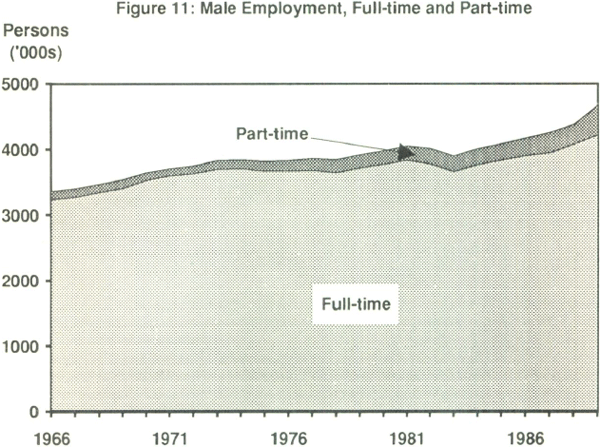
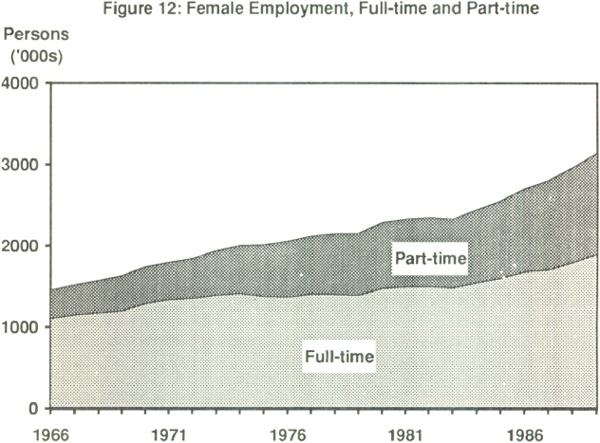
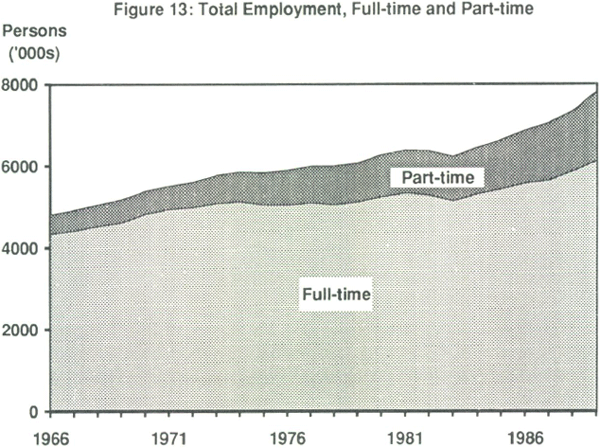
From the data it is clear that part-time jobs – particular for females – grew relatively very quickly from 1966 to 1989. Table 2 reinforces this through the presentation of proportions and rates of growth of the various components, on average and for particular years in order to establish patterns. It shows that the proportion of jobs which are part-time doubled over the period, that around 40 per cent of women now in the labour force are in part-time employment, and that the rate of increase of part-time jobs has been more than three times higher than the growth of full-time jobs.
| Proportions (PT/TOTAL) |
Average Annual Rates of Growth (%) 1966–89 |
|||
|---|---|---|---|---|
| Males | 1966: | 3.7 | FT: | 1.17 |
| 1978: | 5.4 | PT: | 4.86 | |
| 1989: | 9.6 | Total: | 1.35 | |
| Females | 1966: | 24.0 | FT: | 2.41 |
| 1978: | 34.9 | PT: | 5.72 | |
| 1989: | 39.6 | Total: | 3.43 | |
| Persons** | 1966: | 9.8 | FT: | 1.52 |
| 1978: | 16.0 | PT: | 5.46 | |
| 1989: | 20.4 | Total: | 2.08 | |
| * FT = Number of full-time jobs; PT = Number of part-time jobs.
** In April 1986 the ABS redefined ‘unpaid family helpers’ in such a way as to increase the proportion of workers defined as ‘part-time’ which exaggerates slightly the extent of change between 1978 and 1989. |
||||
Recent studies by Gregory (1989) and Dowrick (1988) present analyses of the growth of part-time work. Both document in detail the extent and importance of the experience, a contribution from the latter being a sectoral (industry) breakdown of part-time employment in 1980 and 1987. It is of interest to report that Dowrick concludes that the considerable relative growth of the service sector, an industry characterised by relatively high proportions of part-time jobs, explains a proportion of the shift of job status ‘… but it is the increasing share of part-time work within almost all industries which is the major factor’.[10] In other words, part-time job growth is more or less a general phenomenon, which implies that compositional questions may not be paramount here.
Undoubtedly the rapid expansion of part-time jobs is an important issue in the Australian labour market. But it is probably not yet the case that interpretation of the aggregate jobs data is considerably distorted in the absence of adjustment for part-time work. This is suggested by the data in Figure 14, which illustrates an adjustment for what the total number of jobs might have been given some changes for the fact that part-time work involves less hours than full-time work. The assumption used in this exercise is that each part-time job involves half the time of a full-time job, with no corrections having been made for overtime, the goal being only to illustrate whether or not this particular compositional change really matters for aggregative interpretation.
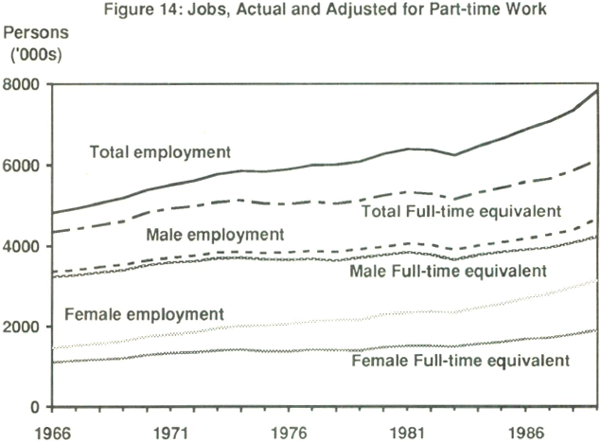
Definitionally, the adjustment results in less ‘full-time equivalent’ jobs compared with each part-time job being treated as identical to each full-time job, as is the case with the aggregate data. But it seems to be the case that this does not affect markedly perceptions of trends, which suggests that the usual employment information does not distort importantly interpretations of job growth. It is wise not to take this revision of the data too seriously, given the lacK of a theoretical underpinning for the exercise.
Economists have so far made little progress in understanding the move to part-time work. Several hypotheses come to mind: the large increase in female real wages in the 1969–74 period[11] raised the opportunity cost of full-time child-rearing and thus made part-time employment attractive relative to non-participation in the labour market; increases in the number of single parents – particularly women – has led to greater individual income needs, particularly when it is recognised that it is highly likely that the average number of adults per dwelling has fallen, implying higher per adult rental or mortgage obligations; and variations in the nature of work, possibly from technological progress, which have resulted in institutional changes allowing decreases in the proportions of full-timers.
The above possibilities have not so far been tested adequately, and much work is needed in the area. The issue matters because, as Gregory (1989) argues, some labour market puzzles are probably best approached with reference to compositional breakdowns related to hours worked and sex. Even given these possibilities, however, it is probably the case that much aggregated analysis can continue without undue concern that part-time/full-time disaggregations distort the picture fundamentally.
(d) The Dynamics of Unemployment
Further potentially useful insights into the nature of and influences on the aggregate labour market come from the realisation that unemployment has both stock and flow dimensions. The important conceptual issues inherent in understanding this may be clarified by considering the following steady state identity:
where U is the unemployment rate in a given period, I is the percentage rate of inflow into unemployment over the period and D is the average completed duration of unemployment as a proportion of the period.[12]
Equation (3) implies that, in a steady state, a given period unemployment rate of 10 per cent could (at one extreme) be a consequence of 10 per cent of the labour force being unemployed for the whole period. At the other extreme, this rate could reflect the entire labour force being unemployed for 10 per cent of the whole period. Both the policy implications and the assessment of the social costs of these possibilities are substantially different. Thus it is important to establish how duration varies both on average over time, and between groups at any point in time.
There are considerable statistical problems inherent in an interpretation of available duration data. In essence this is because individuals' completed unemployment duration is typically unobserved, the labour market life histories of the population not being available. Government agencies do, however, publish data recording the length of time currently unemployed persons have been in this state.[13] While many dimensions could be explored, the focus of the discussion following is on long-term unemployment (LTU), defined here as individuals being currently unemployed for 12 months or longer.
Before analysing the statistics a few observations on measurement and theory are warranted.[14] The labour market may be viewed usefully as continually changing with inflows into, and outflows from, the unemployment stock. That is:
where Ut is the end of period t unemployment level, and It and Ot are respectively inflows into and outflows from unemployment over the period t. The inflows consist of quits (voluntary separations), fires and layoffs (involuntary separations), and jobless new entrants (or re-entrants) to the labour force. The outflows consist of people who find jobs, become discouraged or for other reasons leave the labour force, or who enter labour market programs.
There is some evidence to suggest that the experience of LTU affects the probability of escape from unemployment.[15] This arises for two possible reasons. One is that individuals lose part of their skills (skill atrophy), become discouraged and search less intensively, or that employers (incorrectly) use LTU as a signal of ‘less marketable characteristics’ possessed by the unemployed person. In these cases so-called state-dependence (or duration dependence) arises.
The second reason for the LTU as a group having a lower escape probability is due to the possibility that employers are fully informed and select those job seekers with the more marketable characteristics (that is high escape probabilities), leaving behind those with less marketable characteristics, a phenomenon known as ‘heterogeneity’. In a time series analysis an increase in the number of LTU can result from either, or both, state dependence or heterogeneity. The proportion of unemployment which is LTU can increase also if the probability of re-employment falls for all of the unemployed, which is more likely to occur during a recession when less vacancies arise and more people are competing for each vacancy.
There are at least two reasons for a concern with LTU. The first and most obvious is that there is probably little doubt that persons experiencing LTU are severely disadvantaged in terms of both current and future employment and thus income prospects (Cass (1988)). If escape probabilities are negatively associated with unemployment duration it follows that the LTU become more disadvantaged over time, relative to the employed. Given this, there is arguably an important distributional question associated with LTU.
The second reason underlying a concern for LTU has an efficiency basis. This is that if there is skill loss or attitudinal changes as unemployment duration increases from state-dependence, a greater number (and possibly a greater proportion of the unemployment pool) become increasingly less relevant to the workings of the labour market. It follows that the phenomenon of ‘hysteresis’, in which the NAIRU depends on past and current unemployment rates, is influenced by the proportion of unemployment which is LTU.[16] In simple terms this is because the pool of LTU have less impact on wage bargaining because of their very low elasticity of substitution for employed labour. To clarify the point, in this view a given pool of unemployed, none of which are LTU, has more bearing on the inflation-unemployment nexus than the same size pool dominated by LTU. In other words more LTU, ceteris paribus, shifts the NAIRU to the right.
The above arguments will be an overstatement of the macro-efficiency implications of LTU if it is the case that ‘outsiders’ (all of the unemployed) are in general very poor substitutes for ‘insiders’ since in this situation being jobless is the concern, rather than the length of time of joblessness.[17] This is more likely to be true the more important is firm-specific training [18] and/or the less weight given by unionists in wage bargaining to outsiders in general.[19] The issue is considered more generally in Section 5.
With the above as background it is pertinent to document the Australian LTU experience. This can be done in several ways, the first being absolute numbers by sex, data availability being for 1978–89. Figure 15 shows this.
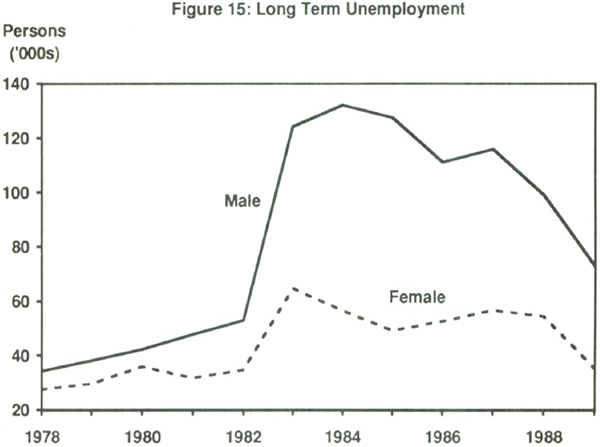
The data reveal that LTU rose dramatically in 1983/84 before beginning a gentle decline. The absolute number of male LTU increased from 34,200 (15.4 per cent of male unemployment) in 1978 to a peak of 132,100 (34.6 per cent) in 1984, falling to 73,000 (28.0 per cent) in 1989. Female LTU increased from 27,600 (15.8 per cent of female unemployment) to a peak of 64,700 (25.4 per cent) in 1983, falling to 35,300 (16.9 percent) in 1989.
Another important dimension in this general area, alluded to empirically above, relates to the proportion of the unemployment stock which is LTU. A useful theoretical perspective has the following two dimensions. The first is that the LTU are placed, by employers, at the back of the job queue, which suggests that as job growth stagnates escape probabilities from unemployment and the outflow rate from the same LTU fall. Secondly, those experiencing short-term unemployment are more likely eventually to become LTU in situations of continuing low job creation, meaning that in such times the rate of inflow into LTU increases.
While most work in this area has concentrated on cross-section and individual panel data sets, recent studies by the OECD (1983), Trivedi and Hui (1987), Budd, Levine and Smith (1988a, 1988b) and Jackman and Layard (1988) report aggregate time series equations estimated including LTU (either absolute numbers or as a proportion of total unemployment), the general conclusion supporting the view that the higher the unemployment rate the higher the proportion of LTU.[20] The only Australian econometric estimates are summarised in Section 6, but it is instructive at this stage to examine the aggregate data, presented now in Figures 16 and 17.
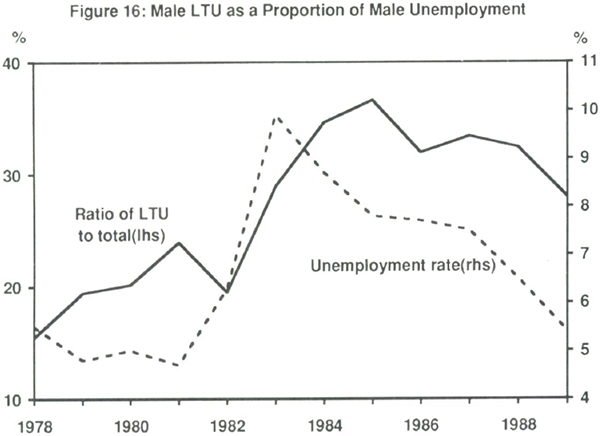
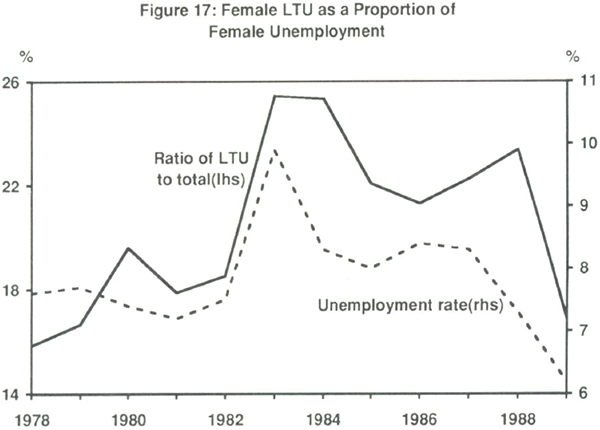
The data in Figures 16 and 17 suggest strongly a positive association between the number of LTU and the proportion of the (measured)[21] unemployed which is LTU, although there is little doubt that the lags involved are complicated. As is now discussed, this empirical reality could be quite important for assessments of the efficient working of the labour market.
e) LTU, the UV Relation and Job Mismatch
Given the data presented above, which show a dramatic increase in LTU around 1983/84 and a slow decrease in both absolute numbers of LTU and its ratio to the unemployment rate, it is useful to ask whether or not this experience has had discernible effects on the efficiency of the operation of the labour market. An appropriate framework in which to consider the issue is that of the unemployment-vacancies (UV) relationship, or the so-called Beveridge curve. For other reasons looking at the UV curve is useful, even if LTU hadn't changed, since its positioning offers insights into labour market efficiency which could have been affected by changes over the period in other variables, such as unemployment benefits and industrial structure. From theory the reasons are as follows.
The UV curve is a convex relationship which means, among other things, that as the aggregate demand for labour increases, vacancies increase and unemployment falls in a non-linear way. As far as labour market efficiency is concerned what matters is the positioning of the curve: the further it is from the origin, the longer, for example, it takes for a given vacancy to be filled, implying higher lost output and wages.
In principle, where the UV relation lies is a function of two things: how aggressively and competently the unemployed search for jobs, and how well-suited employers believe the unemployed are for the available vacancies. The usual variables considered to be relevant then are such things as the level of unemployment benefits relative to the going wage rate (Dow and Dicks-Mireaux (1958), Blanchard and Diamond (1989)), labour market structural measures (Gruen (1978), Harper (1980)) and immigration variables (Hughes (1975), Chapman, Pope and Withers (1985)).
Recently because of the emergence of LTU in both Australia and overseas, research has emerged linking the UV curve to LTU. Some support appears to exist for the proposition that an increase in the proportion of unemployment which is LTU shifts the UV curve outwards, in both Australia (Hughes (1987), Williams (1989)) and, much more obviously, in the UK (Budd, Levine and Smith (1988a)).
The reasons for these findings with respect to LTU are not difficult to understand in theory. An increase in the proportion of the unemployed which is LTU has two effects: it increases the probability that the unemployed on average search less intensively because of discouragement, and it decreases the probability of a vacancy being filled because of employers' beliefs that the LTU are poorly suited to the available jobs.
To gain some insight into whether or not there has been a clear outward shift in Australia's UV curve over the 1980s Figure 18 shows the aggregate numbers. It has one advantage only over William's (1989) econometric analysis using Commonwealth Employment Service (CES) vacancy data in that Australian Bureau of Statistics (ABS) data have been used, it generally being considered that the latter are more reliable, albeit with important gaps. Because other variables have not been controlled for, the relationship shown is indicative, at most.
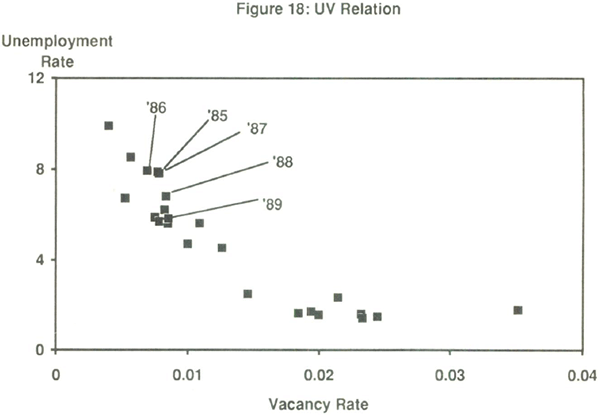
For reasons explored in Section 3(b), the measured unemployment rate is probably not a very accurate representation of joblessness. Consequently, Figure 19 shows the UV relation using the unemployment rate adjusted for hidden unemployment and reported in that section.
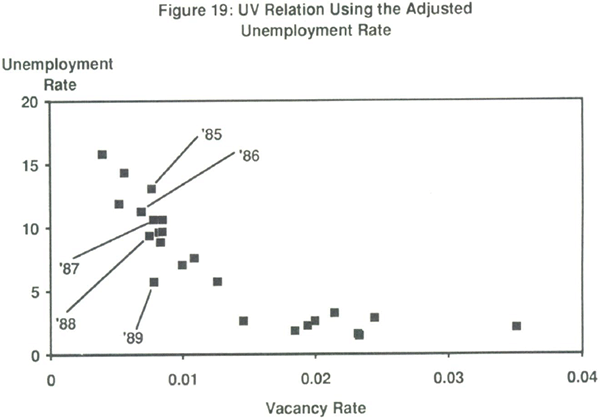
From both figures it is clear that there has been no obvious and large outward movement in Australia's UV relation over the latter part of the 1980s. Indeed, it is possible that at least in 1989 the curve actually shifted in, but not too much should be made of the aggregate pictures. The econometric evidence (Hughes (1987), Williams, (1989)) supports the conjecture that LTU has made the labour market operate less efficiently, but it is difficult to believe that the effects have been large.
4. Wages and Labour Demand
(a) Motivation, and the Aggregate Wage Data
The preceding section documented the linkages between employment and other variables without any analysis being offered on the causes of the first. But the possible connections between real wages and wage inflation on the one hand, and job creation on the other, are obviously an important part of an understanding of the workings of the Australian labour market. This issue dominated the discussion of Gregory and Duncan's (hereafter, GD) contribution to the 1979 RBA conference.
Before exploring the theoretical debate, it is useful to examine the aggregate data over the 1980s. From Section 3 it is clear that employment creation was negative in the 1982–83 period, and strongly positive over 1984–89. The story that wages matter for job growth will look decidedly weak if it is the case that there were no marked variations in the former over the 1980s; more precisely, aggregate evidence that wages are important for jobs would be that there were increases up to 1982 and decreases after 1983. To assist judgements here Figures 20 and 21 illustrate the wage inflation and real wage experience of the past quarter century.
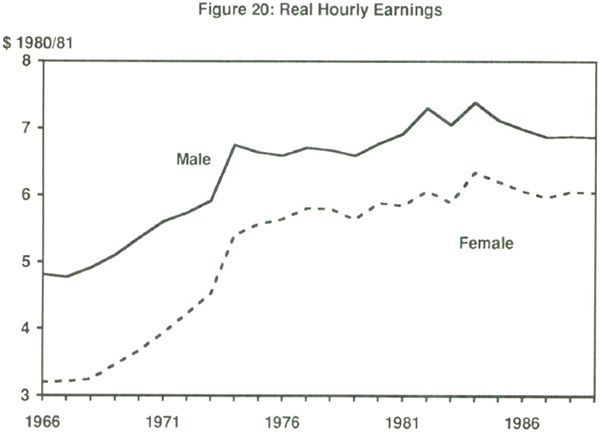
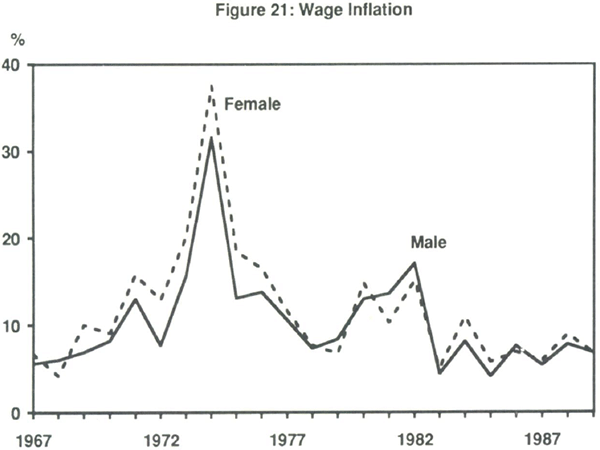
Perhaps a more useful way of considering the possible impact of wages for employment is in relation to real unit labour costs, a measure of the labour costs associated with producing a given unit of output. Conceptually, and in measurement terms, it should be recognised that some indices used are not straightforward to interpret, relevant points being documented by Covick (1984) and Bonnell (1984). The data presented in Figure 22, for the corporate sector, are free of most of these problems.
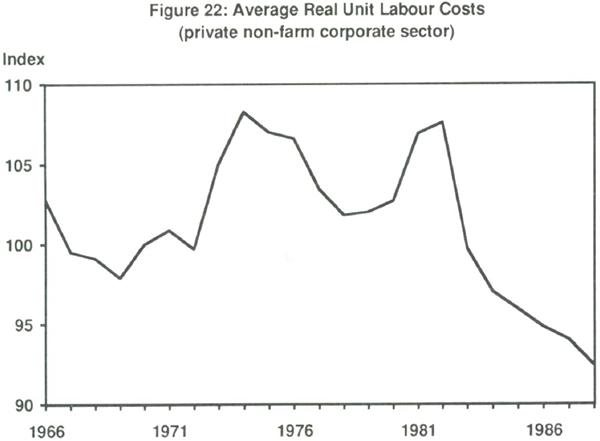
The data reveal that in 1981/82 wage inflation, real hourly earnings and real unit labour costs increased in historically unusual ways: by around 18, 6 and 5 per cent per year respectively. Interestingly, there is somewhat of a precedent for this experience, in 1974/75, when the data were, respectively, around 30–35, 12 and 6 per cent per year. Both experiences were associated with stagnation in job creation, which does not establish causality per se, a caveat reinforced by the recognition of world-wide recession at these times. But it does follow that those arguing that wage changes don't affect unemployment need to be fairly careful in the interpretation of these data.
It is clear also from the figures that wage inflation was relatively moderate, and that both real wage levels and real unit labour costs fell, in the 1984–89 period. The questions of what contributed to this experience are examined econometrically in Section 5. The point for the wages-employment argument here again, however, is that it needs to be noted that the apparent wage restraint in the latter part of the 1980s was associated with rapid job creation, relative to both the past and OECD average experience.
(b) Theoretical Concerns
Over the 1970s the issue dominating the Australian labour market debate was that of the so-called ‘real wage overhang’ (RWO). It is probably not an overstatement to describe the argument as somewhat confused, an observation assisted greatly by hindsight. Ten years on it appears as if the opposing camps tended to put their opponents into extreme positions: by RWO protagonists implying that the other group thought wage outcomes simply did not matter for employment, and by the other group implying that if RWO supporters based their view on short-run capital/labour substitution only, this perspective is apparently contradicted by labour productivity growth data. Careful clarification is warranted.
The essence of the RWO argument is that because of a union wage push in 1974/75 (and in 1981/82), not opposed by the Conciliation and Arbitration (now Industrial Relations) Commission, average real wages became markedly higher than average labour productivity relative to the norm (Covick (1984)). This would imply that the profit share was reduced, and could cause a diminution of investment and a decrease in the rate of job creation. However, some commentators (Jonson et al (1978), Gruen (1978)) chose to emphasise short-term capital/labour substitution, arguments which are now addressed.
The basic reasoning linking real unit labour costs and capital/labour substitution is derived from a neo-classical emphasis on the role of relative factor prices in the production decision, which is now explained in the context of the debate. The argument runs that to correct a RWO employers must in the short-run substitute capital for the now relatively expensive labour. This means that the capital to labour ratio increases, implying that – if nothing else changes – output per employed worker rises. As well, in the medium term, as a consequence of the factor price shift employers find ways of economising on labour, and would do so by choosing to maintain the employment of the most skilled. Again, it follows that output per worker would rise.
GD responded to these implicit empirical predictions in two useful ways. One was to note that what matters for the capital/labour substitution proposition is the relative price of the two factors; however, because of interest rate increases it was probably the case that the price of capital had increased in 1974 more than had the price of labour. By ignoring any scale effects on production from overall cost increases, GD could argue that the relevant substitutions would go in the opposite to predicted fashion: that is, employment growth should have risen in this period.
Secondly, GD examined directly the labour productivity growth data which revealed a decrease, not the predicted increase, after 1974/75. This was explained by reference to a phenomenon well-known to students of micro-labour theory: that of labour hoarding. This is an important point.
Labour hoarding occurs when firms choose not to dismiss labour in recessions because to do so implies the loss of the hiring and training investments which have been financed in part by the firm (Okun (1980), Becker (1964), Schultze (1985)). There is considerable evidence that both these investments exist (Chapman and Tan (1980)) and that they result in firms holding on to (‘hoarding’) labour: instead of dismissing workers the reaction is to cut overtime hours and work employees less intensively. The familiar finding of pro-cyclical movements in labour productivity, reproduced in Australia at this time, was used by GD as evidence that the experience of 1974/75 was a so-called output recession, and not one consistent with the existence of a RWO.
At this point it is useful to update the Australian labour productivity growth evidence, and its possible relation to the business cycle for the period 1966–89. Figure 23 shows hourly labour productivity changes for the non-farm market sector in relation to aggregate job growth. Again, the data are indicative only because of non-trivial measurement issues (INDECS (1990)) and the lack of control for other variables, the latter issue being addressed in the econometric discussion later.
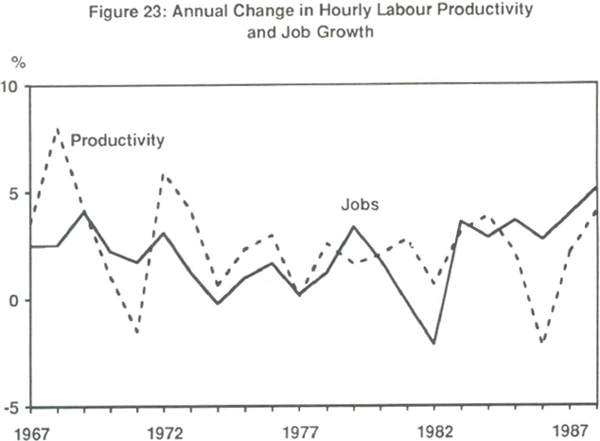
Figure 23 illustrates two things. One is that there is a rough consistency between measures of changes in both hourly labour productivity and the number of jobs, the other being that variations in productivity are probably more pronounced than variations in the number of jobs. Both indicate the presence of labour hoarding, because they imply that in an upswing (downswing) firms work their labour forces more (less) intensively. Obviously econometric work is necessary to make this story strong and this is reported in Section 5(c). It is useful at this point to note that the observed relationships over the extended period do not contradict GD's conjecture in this area.
Getting back to the theoretical perspective, it is apparently the case that the arguments of GD are evidence against one part of the RWO hypothesis, which does not mean that they address the possibility of other links between wage outcomes and job growth. Much of the commentary critical of GD (Higgins (1979), Blandy (1979)) focused on these other relationships. In essence, it was argued, the GD dichotomy between wage and output recessions is false, because among other things such a perspective ignores the input into investment decisions of wage increases.
The role of investment may be extremely important in an understanding of the effects of wage changes on employment. A consensus in this area is elusive, however, because there is no clear agreement as to the influence of particular variables on the investment decision, even if some broad characterisations are not controversial. In general, commentators agree that the cost of borrowing and expected profitability matter, factors which fit easily into Tobin's widely accepted q ratio formulation.
One issue in this area is that ‘expected profitability’ could be influenced by factors related to wage changes. It is not appropriate here to analyse these in detail (see Edey and Britten-Jones (1990)) but it might be useful to at least note two. The first is the current share of GDP going to wage and salary earners which arguably provides a guide to the likely future returns to investment. Apparently (see Figure 3), the wage share increased dramatically in both 1974/75 and 1981/82, for reasons of recession but at least in part because of the considerable increases in real wages and real unit labour costs, implying a concomitant decrease in the profit share.
Secondly, the Australian experiences of rapid increases in real wages have been associated with high wage (and price) inflation,[22] which could have had two important effects on the expected profitability of current investment. One is that if there is a positive association between inflation and the variability of relative prices, a rational reaction by risk-averse business would be to delay investments until uncertainty decreased. A second is the likelihood – probably shared world-wide after the rapid increase in oil and other prices in 1974/75 – that faced with inflation and without alternative mechanisms to deal with it, governments react by instituting restrictive monetary policy designed in part to diminish both consumption and investment.
The above possibilities are conjectures only, designed to establish the proposition that the links between wage changes and employment might be highly complex, indirect, yet important. If this is the case it suggests that stressing short-term capital/labour substitution as the prime explanation of Australian unemployment post-1974/75 and post-1981/82 misses the point. Similarly, and on the other hand, to argue that large increases in wages (real and nominal) are not significant contributors to output recessions is unconvincing. With this as background it is useful to consider a range of Australian evidence on the wages-employment nexus.
(c) Empirical Evidence
Considerable empirical analysis exists for Australia on the relationships between wages and employment, much of which is derived from Australian macro-econometric models (Challen (1984)). These models usually allow several linkages between wage levels and employment, driven dynamically in the main through output responses. Similarly, NIF 88 (the Australian Treasury macro-model), for example, allows for a link to employment from wage change via the effects on investment of real unit labour costs.
Experiments with Murphy's (1989) and the five models examined by Challen reveal similar effects from money wage level reductions, with the short-term channels being capital/labour substitution through real wage cuts and the long-term consequences being driven by the leftward shift in the NAIRU. Conservatively and approximately, the results suggest that an exogenous decrease in the underlying wage inflation rate of 3 per cent per year leads to an increase in employment of around 0.6 to 0.9 per cent per year. The analyses of Lewis and Kirby (1988), Agrawal (1988) and Russell and Tease (1988) reveal statistically significant real wage employment elasticities of −0.8, −1.0 and −0.6[23] respectively.
That there are similarities in the responses, from a range of quite different models, increases confidence that wages matter for employment, although there is no consensus as to the relative importance of the different channels. But the lack of resolution of how wage outcomes affect job creation is not necessarily fundamental to the policy debate, so long as labour costs do impact negatively on employment. If this is the case it follows that institutional or policy variations that affect wages outcomes could be significant in an assessment of the operation of the labour market. Among other things, this possibility is now explored.
5. The Prices and Incomes Accord
(a) Theoretical Issues
Proponents of close variants of the Australian wage-setting system allude typically to the view that centralised decision-making has the potential to deliver favourable macroeconomic outcomes (Hancock (1985)). In the discussion following, both the theoretical basis and the empirical evidence for this proposition are examined.
The theoretical framework is as follows. Small bargaining units do not bear the costs of their action which are borne instead by outsiders to the system. But under consensual incomes policies (defined as ‘wage-setting by central organisations, commanding the obedience of individual workers and employers, to achieve a high level of employment’[24]), the needs of the outsiders – the unemployed – are taken into account. The conjecture from this perspective is that ‘laissez-faire is likely to produce an insider-outsider problem and possibly prolonged spells of high unemployment’[25] and that, by implication, an incomes policy is preferable.
A (somewhat) different way of analysing this issue is provided by Crouch (1985) p. 107), who promotes the importance of public interest wage systems:
‘Social interests that are organized on a small, localised scale receive in full any gain from distortions they produce in market processes but bear only a minute proportion of the general cost; indeed, they share in the general cost of other similar actions, even if they fail to participate. Their only rational course is therefore to try to be sure of their own possibilities for gain through disruption. The position of an interest organized at a national or near-national level will be completely different, as it will experience directly the negative effects of its disruptions it can therefore be expected to take these effects into account.’
Fundamental to the economics of the above is the role of the ‘insider-outsider’ model and the implications of its predictions for the positioning of the NAIRU. Both warrant examination.
The original Phillips curve specification of a negative relationship between rates of wage inflation and unemployment has been subjected to widespread criticism, much of which represents a questioning of its theoretical basis. The most recent contributions to this debate make the point that because of either firm-specific human capital or union bargaining power, or both, it is the employed – the insiders – that determine wage outcomes. The unemployed, particularly those unemployed who are not union members – the outsiders – have little bearing on the process because, in effect, this group has either an extremely low elasticity of substitution for the employed or has needs which are not relevant to the unions.
It follows that unless the employed are altruistic, or worried about their own job loss, wage bargains will be influenced not by the size of the pool of unemployment, but by firm or union-specific labour demand. In a world in which employee-employer implicit contracts are conditioned by the goal of real wage maintenance (Schultze (1985)), it follows that deliberate attempts to decrease wage inflation through a policy-induced diminution in labour demand are unlikely to work. Moreover, even after a protracted period of relatively high unemployment, such as in the 1975–80 period in Australia, union wage bargaining can result in substantial increases in both real wages and wage inflation.
This last possibility is related to the positioning of the NAIRU and in essence implies that the NAIRU is influenced by economy-wide income-settlement arrangements. In this context some recent contributions to analysis of wage and employment determination suggest that the role of labour market arrangements can be crucial (Freeman (1987), Calmfors and Driffill (1988)).[26] The general finding consistent with the above analysis is that economies characterised by high levels of ‘insider-power’ – usually understood to be a consequence of significant firm-specific training or union strength – tend to deliver the highest levels of real wages and/or the highest rate of growth of nominal wages, leading to the least propitious employment outcomes, unless this insider power is marshalled towards a concern for the outsiders.
The key argument underlying the Calmfors and Driffill analysis is that systems in which wage-setting is not decentralised, organised labour has a degree of market power which can be exploited to raise wages. However, such wage increases have effects on other groups. One union's wage rise leads to another union facing price rises; and aggregate wage rises may lead to higher unemployment.
In the Australian institutional environment, with our long history of wage flow-ons (known as comparative wage justice) a clear link exists between the wage gains of one group and the rest of the union movement. It is not difficult to understand why this happens in a predominantly craft-based union system, since a wage gain by a particular union in a firm will be readily observable by members of other unions in the same firm. If senses of ‘fairness’ and ‘equity’[27] matter this is likely to result in a quick spread of wage changes, a proposition that seems to be supported by Australian 1974/75 and 1981/82 experience. That there are a large number of unemployed seems hardly likely to matter.
These approaches imply, as Calmfors and Driffill argue, that there is a hump-shaped relationship between the NAIRU and the degree of centralisation of the wage-setting process. At one extreme, competitive wage setting by many small independent firms and groups of workers is likely to result in relatively moderate wage outcomes. Partial centralisation of wage setting may give the groups market power, which enables them to raise wages and prices without concern for the consequences for other groups, including the unemployed. Further centralisation with a consensus as to the desirability of wage restraint, however, may lead to ‘large and all-encompassing trade unions [which] naturally recognise their market power and take into account both the inflationary and unemployment consequences of wage increases’.[28] As a result, the NAIRU under a consensual incomes policy is argued to be lower than that which occurs under centralisation with no weight being given to outsiders.
In Australia the institutional machinery has long been in place for the operation of a public interest wage system, but the only unambiguous application of the model is that of the prices and incomes Accord, negotiated between the ALP and the ACTU in 1982, and instituted with the change of government in 1983. According to Niland (1987): ‘The Prices and Incomes Accord is a genuine departure from conventional practice, representing a distinct move to the corporatism of social contracts. The Accord itself requires union leaders to discipline their own members, an arrangement without strong precedent in Australian industrial relations.’[29]
It is of some interest to note that in at least one instance a paper prepared by the union movement as background for the Accord recognised explicitly the desirability of helping outsiders: ‘… unions should be concerned about the unemployed generally, whether they are union members or not’.[30] From the above it seems to be the case that the policy initiative allows a simple test of the efficacy of different institutional arrangements on labour market outcomes. In what follows the focus is on wage outcomes which, given econometric control for unemployment and other measures of the strength of the labour market, is tantamount to an analysis of the effects of a consensual incomes policy on the NAIRU.
(b) Econometric Estimation of Wage Outcomes Under the Accord
The question implied by the above is, has the Australian movement from a strong union country without a public interest wage system to a consensual incomes policy mattered for the NAIRU? This is now addressed.
Interestingly, one of the most obvious – albeit implicit – goals of the Accord was to decrease the rate of nominal wage increases in order to set the scene for employment expansion. It is reasonable to presume that both wage inflation and real wages mattered to the Accord partners: nominal wage growth needed to be decreased because this would militate against the use of restrictionist fiscal and monetary policy as an inflation instrument, and real wage growth had to be controlled to maximise decreases in real unit labour costs, thus allowing concomitant expansions in the profit share and so helping to create the appropriate environment for increased investment and job growth. To address the issue of whether or not the Accord affected wage outcomes Chapman and Gruen (1990) invited five practitioners of wages estimation in the Australian macroeconomy to participate in a modelling exercise now described.
Given that there are different ways of understanding nominal and real wage relationships, from both theory and with respect to specific evaluations of institutional influences, Chapman and Gruen avoided judgements of the relative efficacy of the wage models, their goal being the fairly simple one of investigating from a purely empirical perspective whether or not dissimilar models tell similar stories. Thus the equations were not explored in terms of their logical foundations, consistency with theory, or even the statistical properties revealed in the estimations.
Two basic approaches were used in the testing of the proposition that a structural break occurred in wage relationships after the institution of the Accord. The first was to estimate all models from the start of their data, usually the late 1960s, to 1983(1), to use the parameters to predict the dependent variable out-of-sample over the period of the Accord. This was assumed to begin in 1983(2) and to be in operation for all observations for which data were currently available. A comparison of the predicted with the actual wage outcomes is indicative of the existence or otherwise of a structural break, which was interpreted as being a consequence of institutional change.
The second method used is similar to this, but is both less flexible and more straightforward to interpret. Models were estimated over the entire period with the inclusion of an intercept-dummy variable equal to one for the Accord period and equal to zero otherwise, which provided a simple test of the average effect of changes in macro-economic wage relationships. The dummy variable approach has desirable small sample properties but constrains the slopes of all other relationships to be identical across the whole period.
A detailed discussion of the five models, focusing on their distinctive features, is in Chapman and Gruen (1990). Three of them – Treasury's NIF 88, and those of Chris Murphy and Bill Mitchell – have wage inflation as the dependent variable. The other two, from Phil Lewis and Ian Russell are concerned with the determination of real wages.
The choice to estimate the models to 1983(1) was not a straightforward decision because of the possibility, raised by some commentators, that the wages pause initiated in December 1982 had significant effects on wage outcomes well past the initiation of the Accord. This point is addressed in discussion of the results.
The estimations revealed that none of the equations exhibited obvious stability or functional form problems, which qualifies them adequately – in a statistical sense – to be participants in the simulation approach. The results of the simulation exercise are now presented graphically, in Figures 24 to 28, with the econometric analysis on which the projections are based being available in Chapman and Gruen (1990).
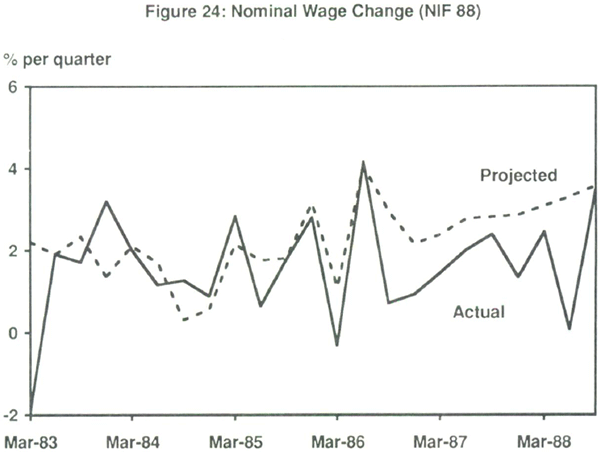
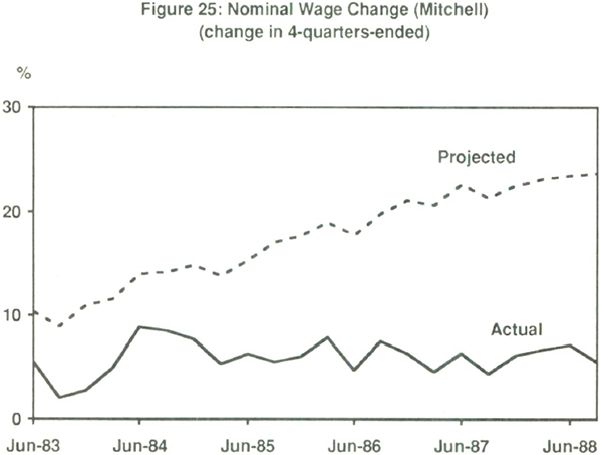
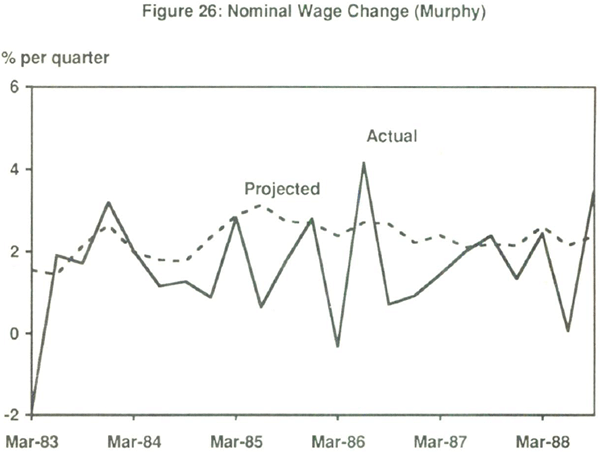
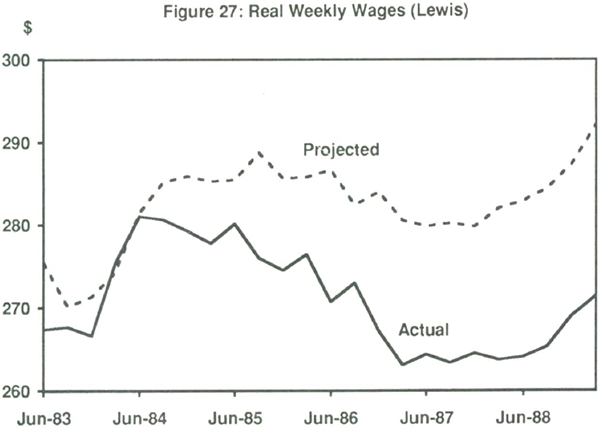
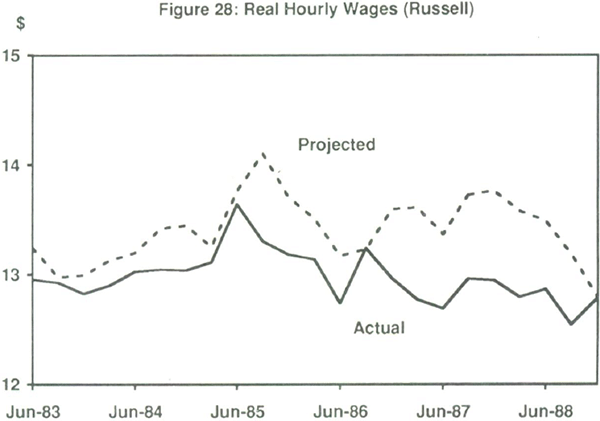
The intercept-dummy variable approach was used also in all five models, with the econometric results and further diagnostics from the full-period estimation being available in Chapman and Gruen (1990). The methodologies explained above are very simple and may hide important information which could ultimately turn out to be fundamental to our understanding of incomes policies and wage adjustment processes. As well, no clear consensus exists, but the following points are worth highlighting.
First, the weakest statement to be made is that in no model is the Accord associated with wage increases exceeding those projected on the basis of the pre-Accord period, which must cast doubt on the views held by some (for example Moore (1989)) that the Accord has held wage levels above what would otherwise have been achieved. Indeed, in three cases there are statistically significantly lower wage outcomes after 1983(2) on average than predicted by the models. In the nominal wage change equation of NIF 88 and the real wage level equation of Russell there is a statistically insignificant negative effect but the size of the coefficient is about the same in these respectively as for Murphy and Lewis.[31]
Secondly, the tests on Mitchell's nominal wage change and Lewis' real wage level models reveal both large and highly significant structural breaks after 1983(1). Those arguing that consensual incomes policies are irrelevant to macro-wage outcomes must come to terms with the evidence from these two models supporting strongly the opposite conclusion.
Thirdly, even though the results of tests of statistical significance differ between models, there are some obvious similarities in directions and sizes uncovered. All Accord dummy variable coefficients have negative signs, and taking the coefficients literally (that is, ignoring significance) the quarterly nominal wage change estimations of NIF 88 and Murphy reveal about the same order of magnitude, around 3 percentage points lower per year growth (that is, if projected wage inflation is 11 per cent a year, the (presumed) incomes policy effect is to reduce it to 8 per cent a year). As far as real wage levels are concerned, the Lewis and Russell Accord coefficients both imply around a 9–10 per cent reduction over the period, although in the latter's model the effect is statistically insignificant. Mitchell's annual nominal wage change approach is not directly comparable to the others, but as noted his estimated Accord effects are unambiguously large and highly significant.
Fourthly, it is worth noting from the figures that over the course of the Accord the differences between projected and actual wages (for both changes and levels) becomes more apparent in all models, except for the last quarter of 1988. This suggests two things. One is that the incomes policy effects probably changed over the course of the Accord, which implies that the results from the intercept-dummy approach – which constrains the effect to be constant for the whole period – should be treated cautiously. Another point to make is that the early similarities between projected and actual wages, compared to the last three or four years of the Accord, suggests both that the coalition-initiated wages pause in December 1982 did not have substantial long-lasting effects on outcomes, and that the real wage cut of 1986 in response to the devaluation demonstrates that the Accord could accommodate changed economic circumstances.
An implication of the apparent increased divergence between projected and actual wages is that if ‘catch-up’ in wages is seen to be an eventual characteristic of incomes policies, the Australian experience is either idiosyncratic or ‘eventual’ has not yet come. Related to this, and worth stressing, is the point that the results reveal generally and fairly obviously that there has been as yet no wage ‘break-out’ (as experienced in 1974/75 and 1981/82) over the six years after 1983(2).
Fifthly, is that while so-called Accord effects are not statistically significant in the NIF 88 and Russell estimations, in these experiments projected wage outcomes lie above actual experience for most quarters, in proportionate terms 74 and 96 per cent respectively. For the Mitchell, Murphy and Lewis projections the corresponding percentages are 100, 70 and 96 respectively. While suggestive only, this evidence makes it difficult to believe that the institutional influences on wage outcomes were identical before and after 1983(2).
It would be interesting to compare these outcomes with similar modelling approaches estimated for other countries. Indeed, until this is done, strong and unambiguous conclusions concerning the role of the Accord in restraining wages are unwarranted since it is possible that the wage inflations seemingly followed by recessions in 1974/75 and 1981/82 have changed workers' attitudes to wage rises, both in Australia and internationally. However the manufacturing real wage change data, presented in Figure 2, suggest that the Australian wage experience has been different to the average of the OECD, a proposition confirmed by the recent OECD (1990) report on the Australian economy.
A final additional comment of most relevance to the simulation method concerns the possibility that the Accord impacted upon some of the regressors in the wage models, implying that the effects illustrated are only part of the story. Without the Accord it is possible that labour demand and wage pressures would have been lowered in ways not captured by the equations, the point being that the observed differences between predicted and actual wage outcomes capture only direct effects. This is a limitation of reduced form modelling.
Even given these caveats, Chapman and Gruen argue that the exercise revealed what might reasonably be described as Accord effects on wages, or more carefully, changes in wage growth and levels not explained adequately by measured influences over a broad range of models with parameters estimated on the basis of past experience. They conclude by noting that the case for the Accord having restrained wages is made more easily than is the case for it having had no effect. In an interpretation of these results, Chapman, Dowrick and Junankar (1989) suggest that it is plausible and conservative to argue that the Australian incomes policy effects were to reduce wage inflation by three percentage points per year, and to cut real wages by 10 per cent from 1983 to 1989.
Potentially the above is profound news for analysts of the role of wage-setting institutions in determining the positioning of the NAIRU. That is, it seems to be the case that the Australian movement to a consensual incomes policy has had the effects predicted by Calmfors and Driffill and others. If this is true it implies that the NAIRU is neither fixed nor impervious to policy, a conclusion which promotes the usefulness of insider-outsider wage bargaining models. The bottom line seems to be that wage bargaining institutional arrangements really matter for the operation of the aggregate labour market.
(c) Criticisms of the Accord: Labour Productivity Growth Revisited.
A popular pastime in the 1980s for economists and others was that of criticism of the Accord. In political terms opponents of the incomes policy fell into two camps: those who argued that the new arrangement was undemocratic because it gave policymaking power to groups, most obviously the ACTU, who were not answerable to voters (Chipman (1985)); and those who believed that workers covered by awards had borne the brunt of the post-1983 labour market adjustments so that unfair redistributions of the economic cake had taken place, most clearly towards profits on the one hand and the upper echelons of the labour force (management and professionals), not covered by the award system, on the other.
Much of the criticism of the Accord manifested itself in economic and empirical judgements. These frequently included: predictions that the Accord couldn't last the next short period; assessments that the incomes policy was mostly just rhetoric about consensus since it had had no independent effects on either industrial disputation or wage levels; and, most recently, that the (alleged) increased wage rigidity had inhibited the rate of growth of labour productivity.
Much of the debate is largely settled in that while the Accord has changed form considerably, at the end of the 1980s most commentators seemed to agree[32] that as an instrument for aggregate wage restraint it has lasted and apparently has been influential. As well, a series of econometric exercises (Beggs and Chapman (1987a, 1987b, 1987c), Chapman and Gruen (1990)) suggest strongly that strike activity in Australia declined after the second quarter of 1983, independently of the influence of the usual macroeconomic variables and relative to the average of the rest of the OECD, although declines in strike activity were a world-wide phenomenon. Two caveats might matter here: one is that industrial bans seem to have become more frequent over the 1980s, implying the possibility that less conspicuous forms of industrial disputation have partly taken the place of strikes (Sheen (1990)); and two, the increased willingness of employers to revert to legal and other actions as a weapon against strikes (such as in the Mudginberri, Dollar Sweets and Robe River disputes) may have had independent dampening effects on industrial conflict, although because of the timing of these incidents it is hard to believe that this effect was important before 1986.
Lately the most commonly heard criticism of the Accord relates to growth in labour productivity. While a clear statement of the likely effects of a consensual incomes policy on labour productivity is hard to find, the following possibility warrants attention. This is that the wage inflexibility resulting from substantial compliance to centralised wage-fixation inhibits the efficient operation of the labour market and thus decreases the likelihood of the attainment of maximum possible productivity gains over time.
Several recent econometric studies (OECD (1990), Dowrick (1990b)) throw light on this issue, but before examining the results it is useful to explore some of the complexities in the area. They relate to measurement and a conceptual framework with which to analyse labour productivity growth.
Superficially in data terms labour productivity growth seems straightforward, being defined as the rate of increase of the value of output produced per employed unit of labour. But as in most areas of labour economics issues of measurement are very important and conclusions contingent on what the data mean. There are two major concerns.
The first is that it is very difficult to measure the value of output in some sectors of the economy (such as services, finance and government). As a consequence the Australian Bureau of Statistics imputes a value of zero to the growth in labour productivity in these sectors. This is irrelevant to assessments of aggregate performance over time only if there are no compositional changes in output, which is very unlikely to be the case (see Figure 29 below).
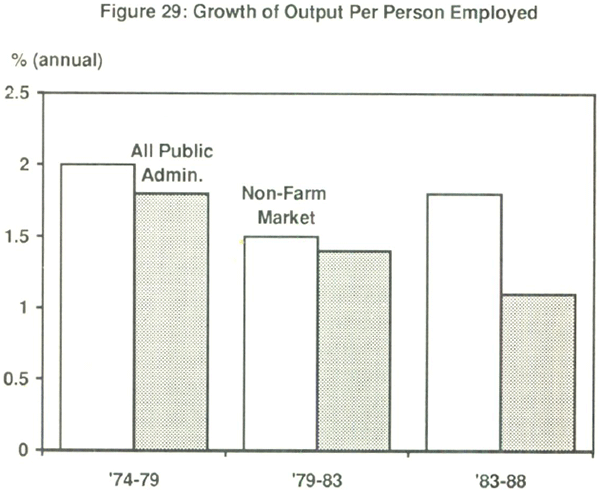
A second labour productivity measurement issue relates to the unit of input. Often ‘persons employed’ is used, but this is not ideal because increases in overtime, or changes in the full- and part-time composition of jobs, necessarily affect the productivity growth measure even if there has been no change at all in labour efficiency. As well, the differences in the indices will vary over the business cycle given some labour hoarding. Two things follow: one is that conclusions concerning underlying labour efficiency changes will depend on which denominator is used; the other is that the hourly data should be preferred to the per person measure.
These measurement concerns imply that much more care is needed in interpreting labour productivity growth data than is often given, particularly in public debate. They also suggest that the more aggregated is the information used the less confidence should be placed in it as a reflection of the strength of underlying forces. By implication, international comparisons of, for example, changes in GDP per person employed, should be treated with great caution. But measurement issues pale into insignificance relative to some of the conceptual issues inherent in understanding the possible relevance of institutional factors, such as the Accord, on labour productivity growth.
Hourly labour productivity is a many splendoured thing. Among other things, it will be influenced by the quantity and quality of capital available per worker and the extent of labour hoarding. It follows that a fair assessment of the possible role of the Accord must control, as far as is possible, for these variables. Both the OECD and Dowrick do this.
In comparing the analyses an important issue of measurement arises. This is that the OECD study uses data covering the so-called Business Sector, which includes several sectors to which the Australian Bureau of Statistics attributes zero hourly productivity growth, such as Finance, Property and Business Services. However, Dowrick's study is only for the so-called market sector, which does not have this problem. Compositional changes in output over the 1980s imply that more accurate insights into underlying productivity influences are forthcoming from Dowrick's analysis.
To illustrate that this measurement difference can really matter, Figure 29 shows (approximations of)[33] the average data used in each study. ‘Non-farm market’ corresponds to the information used by Dowrick, and ‘All-Public Admin.’ (GDP apart from Government) is close to what has been employed by the OECD.
Two points arise from this comparison. The first is that the OECD study is more likely to find a labour productivity slowdown for the 1984–88 period than is the Dowrick analysis, purely for reasons of measurement, since Finance and Other Services became more important over the 1980s. Secondly, even though non-farm market-sector labour productivity growth seemingly increased after 1983 relative to the preceding four-year average, this does not mean necessarily that the Accord has been associated with increases in labour efficiency, because many other things changed. Econometric work is needed.
Dowrick's method, which is essentially the same as that used by the OECD, models labour productivity growth as being determined by the extent of labour hoarding (as measured by output growth), the capital/labour ratio, and underlying ‘structural’ and institutional influences, such as the Accord, as represented by time categories. His results, and those of the OECD, confirm strongly conventional theoretical perspectives on the determinants of labour productivity growth: work-intensity, the other side of the labour hoarding coin, is very important, as is the capital/labour ratio. Changes in the latter seem to be extremely relevant in an explanation of the post-1983 slowdown.
The important point for the Australian policy debate is that Dowrick's results reveal that while average labour productivity growth declined in the 1983–89 period relative to the preceding decade, just about all of this is because employment grew so quickly relative to investment, particularly up to 1988. In other words, to attribute to the Accord the relatively low rate of growth of labour productivity over the 1983–89 period is accurate only in so far as the Accord was a significant factor behind the extraordinary growth in jobs. So-called ‘capital dilution’ had an important effect and, while labour hoarding was a factor working in the opposite direction, no other statistically significant effect is identified. The results were basically replicated in an internationally-comparative econometric exercise using GDP per person employed.
A further implication of the analysis is that labour productivity has not increased as a consequence of the ‘second-tier’ or other approaches aimed at breaking-down workplace inefficiencies. Those arguing that the Accord has facilitated movements away from some restrictive work practices will find no support in the econometric work for the proposition that this has had discernible effects on output growth. Instead, the data support strongly a conventional economic theory interpretation emphasising the role of labour hoarding and the importance of capital per unit of labour employed. The fomer is stressed by GD, and the latter is a prediction of the RWO.
A caveat to the above is the possibility that the rapid employment expansion after 1983 drew inferior labour into jobs, which resulted in less output per worker. Very little modelling of this possibility exists, but it is highly likely that its effect is picked up with the cyclical variable. Importantly, this measure shows typically and strongly the opposite conclusion to that predicted by an inferior quality of labour perspective.
It is instructive to relate these conclusions to two points made in preceding sections. The first concerns the doubt expressed by GD of the value of the short-run neo-classical factor substitution model as a useful tool in understanding aggregate labour outcomes. A possible reconciliation of their position with the labour productivity growth econometric results lies in the fact that all factors are variable in the long run. The story supported convincingly is that relative decreases in the price of labour lead to employment expansions greater than plant and equipment increases, resulting in lower output per worker. Clearly, there have been substitutions into labour even when investment has been high.
Secondly, these data in combination with the wage results reported by Chapman and Gruen help considerably in an interpretation of Figure 3, which shows that the Australian share of GDP paid to wage and salary earners changed in much the same fashion as did the same for the unweighted average of the rest of the OECD over the 1980s. Since it is apparently the case that Australian wage decreases were relatively high in an international context after 1983, the seeming relative constancy of factor shares means that labour productivity growth was low in this country and high in the average of the others.
While the Australian labour productivity growth experience can be understood to be mainly as a consequence of rapid employment growth, analysts of other countries (for example, Metcalf (1990), on the UK) argue that productivity growth can be increased by changing industrial legislation. If this is the case a fruitful area of research would be in international comparisons of the role of institutional arrangements on wage outcomes and productivity growth.[34] At this stage the Australian evidence implies that a consensual incomes policy has the potential to restrain wages and has little observable effect at the aggregate level on labour efficiency. But the latter finding does not imply generally that policy stances and institutional changes have no role to play as influences on underlying structural labour productivity performance.
6. Conceptual and Empirical Linkages
(a) Introduction
It is possible and useful to link conceptually the theoretical and empirical material of Sections 3 to 5. What has been suggested so far is that: labour supply is affected by job growth, and perhaps real wages; employment is influenced by wage outcomes, probably by both real wage levels and wage inflation; that the Accord has had a restraining effect on both real wages and wage inflation; and that there have been no obvious changes in labour productivity growth not explicable by cyclical effects and the relatively rapid growth of employment. Taken together these relationships imply linkages between a consensual incomes policy, wages, labour supply, employment (and thus labour productivity) and measured unemployment, the last of which seems to affect the level of LTU. Schematically the above can be represented as follows:
The figure is a simple model of the intricate relationships within the aggregate labour market. Most clearly it is deficient with respect to the connection between employment and labour productivity growth, because this linkage is about both labour hoarding (work intensity increases related to job growth) and factor substitutions (the movement into labour more than capital as a consequence of relative cost changes). Even so, as a representation of broad connections and as a promotion of policy issues the diagram is useful.
A challenge is to determine the empirical magnitudes of these relationships. As with the estimated effect of the Accord on both wage inflation and real wage levels, it is necessary to refer to econometric evidence. Armed with this information it is then possible to explore the question of what the Australian labour market might have looked like at the end of the 1980s in the absence of the structural change in wage bargaining presumed to have happened in 1983.
(b) Econometric Evidence on Labour Market Linkages
Empirical evidence has been offered above on several of the linkages illustrated in Figure 30. In particular, the move to a consensual incomes policy has been argued (conservatively) to have reduced the NAIRU in such a way as to have decreased wage inflation by three percentage points per year, and real wage levels by 10 per cent for 1983–89 (or 1.67 per cent per year on average), ceteris paribus. As well, through reference to a host of macro-econometric models, and employment equations, a plausible estimate of the effect of money wage cuts of three per cent per year is to increase employment by between 0.67 and 0.9 per cent per year (Challen (1984), Murphy (1989)), and a real wage cut of 1.67 per cent per year is associated with an employment expansion of between 1.02 and 1.67 per cent per year (Lewis and Kirby (1988), Agrawal (1988), Russell and Tease (1988)). In other words, for the six years 1983–89 the estimated ceteris paribus employment increase from the structural change in wage-bargaining probably lies between 3.7 and 10 per cent (Chapman, Dowrick and Junankar (1989)). What this means in terms of jobs is set out in Table 3.
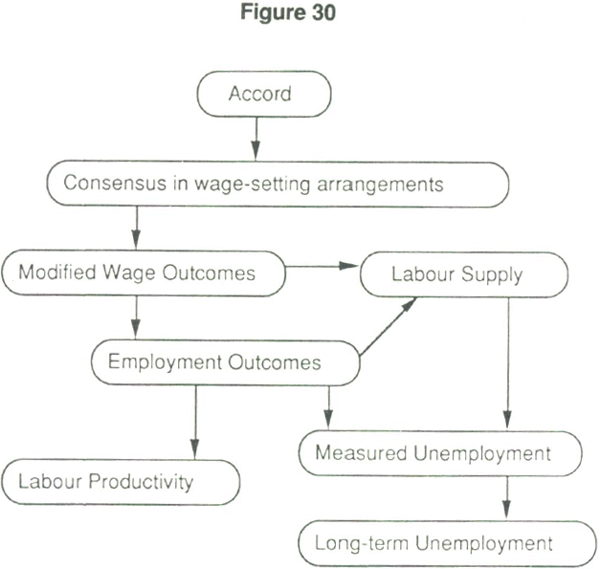
| Nominal Wage Inflation | Real Wage Levels | |||||
|---|---|---|---|---|---|---|
| Model: | Murphy | Challen | Agrawal | Lewis and Kirby | Russell and Tease | |
| Job growth % 1983–89 | 3.7 | 5.4 | 10.0 | 8.0 | 6.1 | |
| Additional jobs by 1989 | 289,000 | 423,000 | 782,000 | 626,000 | 477,000 | |
It is important to be clear as to the meaning of the data of Table 3. The Murphy experiment reported in Chapman, Dowrick and Junankar (1989) suggests that the Accord reduced the equilibrium NAIRU from 6.37 per cent to 4.16 per cent, with the estimated 3.7 per cent employment growth[35] over the period implying about 290,000 additional jobs. The data associated with Challen result simply from imposing a 3 per cent lower money wage level per year than would otherwise have been attained. Since his overall assessment of Australian macro-models suggests that a 10 per cent cut in money wages was associated with a 3 per cent increase in employment, it is assumed that a 3 per cent cut in wage levels (or wage inflation) implies a 0.9 per cent annual growth in employment, or around 420,000 extra jobs for 1983–89. The real wage effects estimated from, Agrawal, Lewis and Kirby, and Russell and Tease of a 10 per cent reduction have been translated into employment consequences by multiplying their elasticities by 0.1, which implies total job creation of about 780,000, 630,000, and 475,000 respectively. Lewis and Kirby (1988) did their own estimates of the effect of the Accord on employment with the same result reported for them here.
It is important also to understand what the data of Table 3 do not mean. The only alleged impact of the Accord identified here arises from the assumed structural change in the wage inflation and real wage processes. It is possible that the Accord had other, indirect, effects on employment, one plausible avenue being through increased business confidence and investment as a consequence of diminished strike activity, referred to already. On the other hand, some commentators assert that increased centralisation in wage-setting processes decreases flexibility at the firm level (Moore (1989)), which might suggest that there may be adverse long-run implications which have not shown up so far in the data. The point is that estimates have been produced here only of the direct short-term employment consequences of the consensual incomes policy.
From the above it would seem to be a reasonable – even conservative – judgement that the Accord, through its effects on the structure of wage relationships, resulted in 4 per cent employment in 1983–89 over and above what would have eventuated had there been no changes in institutional arrangements. This amounts to around 310,000 jobs for the period. Two reasons the assessment is probably conservative are: that an averaging across the wage-employment models suggests a figure in excess of 500,000 jobs; and that the wage decrease assumed lies very much towards the low end of the incomes policy effects reported in Section 5.
The next linkage concerns the effects of real wage changes and employment growth on labour supply. These elasticities are derived from Dowrick (1988), in which labour force participation equations were estimated for ten separate sex and age groups. Participation was modelled to be a function of real wages, the employment/population ratio, and trend.
The results suggest that participation rates are pro-cyclical after the late 1970s for all groups except prime-age males and older women. This implies that the discouraged worker effect analysed in Section 3 is particularly strong for women under the age of 60, for older men, and all youth. The aggregate response is that for every 100 extra jobs, about 40 people join the labour force and unemployment drops by 60.
On the other hand the real wage effects on participation are mixed: for men they are statistically insignificant for the period since the late 1970s, except for those aged under 20 years whose participation responds positively to real wage rises. The own-wage effect for women under the age of 55 is generally positive – implying that leisure-work substitution does occur – but it is apparently offset by a negative income effect of the male wage on adult participation. These are important research findings since they help explain both why aggregate participation equations show no real wage effects (Murphy (1988)), and why the total real wage absolute elasticity is small in this research – less than 0.25 at the sample means in Dowrick's analysis.
These participation relationships mean that the changes in employment and in real wages which have been attributed to the Accord have in turn had impacts on labour supply, with just about all of the effects operating through the former. The supply consequences, together with the employment changes discussed above, allow an estimate to be made of the effect of the consensual incomes policy on the (measured) unemployment rate, data now presented in Table 4.
| Actual | Alternative | Accord Effects | ||
|---|---|---|---|---|
| 1983 | 1989 | 1989 | ||
| (i) | (ii) | (iii) | ((ii) – (iii)) | |
| Female participation rate (%) | 51.7 | 60.4 | 58.5 | 1.9 |
| Male participation rate (%) | 83.5 | 84.5 | 83.8 | 0.7 |
| Total participation rate (%) | 68.0 | 72.7 | 71.4 | 1.3 |
| Unemployment rate (%) | 10.0 | 5.9 | 8.0 | −2.1 |
These data suggest that because of the assumed real wage decreases and employment growth arising from structural changes in the 1983–89 period, both male and female participation rates were higher than they otherwise would have been, the counter-factual being entitled ‘alternative’. If the job growth assumed to have been associated with the consensual incomes policy had not occurred, and everything else had remained the same, the measured unemployment rate would have been 8.0 per cent in 1989, rather than the actual 5.9 per cent.
Given the decrease in the measured unemployment rate presumed to be associated with the Accord, it is possible to determine what consequences this has had for LTU. In theory, apparently supported by the data of Figures 17 and 18, the proportion of unemployment which is LTU depends on the unemployment rate. Econometric analysis of the relationships between the proportion of unemployment which is LTU and unemployment rates, presented in Chapman, Dowrick and Junankar (1989), were estimated separately by sex, and controlled for trend and seasonal dummies. They allow insight into the consequences for LTU of the decreases in unemployment.
For males, while there is a long and complicated lag distribution, a one percentage point decrease in the male unemployment rate is associated with a long run fall of 2.6 percentage points in the proportion of the male unemployed which is LTU, with 50 per cent of this effect occurring within seven quarters. For females, a one percentage point decrease in the female unemployment rate is associated with a reduction of the proportion of the female unemployed which is LTU by about 3.8 percentage points, half of this effect being reached after only three quarters.
These estimates imply that, if the Accord reduced (measured) unemployment by around 2.1 percentage points, the associated fall in the (aggregate) proportion of unemployment which is LTU is around 6 percentage points, that is from a hypothetical (non-Accord) world in 1989 of 29 per cent to the observed 23 per cent. In absolute numbers this represents a fall in 1989 LTU from a hypothetical 186,000 to the observed level of 108,000, a difference of the order of 78,000 persons.
Analysing what labour productivity would have been in the absence of the employment growth attributed to the consensual incomes policy is more complicated than is the case for the same exercise with other variables. This is because there are trend and cyclical components, and a capital/labour ratio effect. A (very) simple way of approaching this issue is to explore what the econometric results imply about the relationship between employment growth and labour productivity growth and to infer, in a linear way, what this suggests about what the latter might have been without the job growth associated with the Accord. This can be done by comparing the expansion of employment and productivity of 1975–83 with that of 1984–88.
Given that the employment growth attributed to the Accord of about 0.7 per cent per year is about 20 per cent of what actually occurred in 1984–88, this suggests that 80 per cent of the capital dilution effect is attributable to other employment-creating factors. If a similar approach is used to interpret cyclical effects, by reference to the 1975–83 experience it follows that the consensual incomes policy effect was to reduce labour productivity growth overall by about 0.25 percentage points per year. In other words using this very simple (and linear) method, the effect of the Accord on labour productivity growth was to reduce labour efficiency in the market sector from a hypothetical 2.15 per cent per year to the observed 1.9 per cent per year, all of which is a result of the relatively high employment expansion.
(c) Summary
The exercises reported above have drawn on the theoretical and empirical material of earlier sections, and have used recently available econometric evidence, to consider the overall labour market consequences of the adoption of a consensual incomes policy in 1983. The approach has been to note the linkages between changes in wages and employment on the one hand, and the implications of these for labour supply, labour productivity growth, the unemployment rate and thus LTU on the other.
The evidence presented in Section 5 was that wage inflation and real wage levels were reduced respectively by about three percentage points per year and 10 per cent overall for 1983–89 as a consequence of the incomes policy. These data have been used to pose the following counter-factual question: what would the major Australian labour market variables have been in 1989 in the absence of these wage changes? Table 5 summarises the results.
| Actual | Estimated | Accord | ||
|---|---|---|---|---|
| 1983 | 1989 | 1989 | ||
| (i) | (ii) | (iii) | ((ii)–(iii)) | |
| Average real adult hourly earnings ($1980/81) | 7.05 | 6.82 | 7.52 | −0.7 |
| Employment (000s) | 6,241.1 | 7,800.0 | 7,488.0 | 312.0 |
| Male labour force (000s) | 4,333.3 | 4,883.0 | 4,859.0 | 24.0 |
| Female labour force (000s) | 6,927.9 | 8,292.3 | 8,161.3 | 131.0 |
| Unemployment (000s) | 686.8 | 492.3 | 641.1 | −148.8 |
| Unemployment rate (%) | 10.0 | 5.9 | 8.1 | −2.1 |
| Long term unemployment (000s) | 189 | 108 | 186 | −78 |
| Long term unemployment (Proportion of unemployment, %) | 27 | 23 | 30 | −7 |
| Growth in labour productivity p.a. (%) | 2.2+ | 1.9* | 2.15* | −0.25* |
| + Average, non-farm market sector, 1975–83 * Average, non-farm market sector, 1984–88 |
||||
The data reveal that achieving lower wage outcomes than would otherwise have occurred has important consequences for many areas of the labour market. Lower wage inflation attributed to the consensual incomes policy initiated in 1983, of the order of three percentage points per year, is estimated to have: increased the number of jobs by over 300,000; increased male and female labour supply by 24,000 and 131,000 respectively; decreased the number unemployed by about 150,000; and reduced LTU by about 85,000. Labour productivity growth would have been higher without the Accord, a result driven by the extremely rapid growth of jobs relative to the capital stock, and apparently not for structural or institutional reasons.
The counter-factual, of course, is hypothetical, there being little doubt that in the absence of the Accord other, probably unpredictable, institutional or policy changes would have eventuated which may have affected the NAIRU. Nevertheless, comparing actual outcomes with a scenario predicted on the basis of recent history has pedagogic benefits for policy assessment.
The experiments reported here serve other purposes. One is that they demonstrate the importance of linkages within the labour market. Apparently it is the case that measured labour supply is endogenous to job growth, which suggests that the unemployment rate is influenced by wage changes through two offsetting channels. To make the linkages point more starkly, the evidence supports the proposition that changes in wages affect both the proportion of unemployment which is long term and the rate of growth of labour productivity.
7. Concluding Thoughts
In labour economics a decade is a long time. Ten years ago there seemed to be no agreement as to the existence of a relationship between wages and unemployment, very little discussion as to the likely effects or desirability of consensual incomes policies, and almost no attention was paid to long-term unemployment. In significant ways much of this has changed.
The differences between now and then have their empirical roots in the events of the early to mid 1980s. The marked increase in wages in 1982, associated with the most severe recession in 50 years, was followed by unusual wage restraint and rapid job creation. These experiences made it difficult to believe that labour costs didn't matter for jobs, even acknowledging that the evidence presented for this proposition a decade ago was weak.
Undoubtedly the striking deterioration of employment in 1982 was an important factor leading to the signing of the Prices and Incomes Accord, Australia's first consensual incomes policy. It represented an attempt to encompass potentially renegade unions in a pact designed to moderate wage growth, and was in part motivated by the goal of overall employment expansion. Consequently its institution allowed a test of insider-outsider theory.
In macro-economic terms it is hard to believe that the Accord has not delivered what its proponents apparently hoped for: wage restraint and job growth, leading to a substantial – and, because of measurement problems, an understated – decrease in the unemployment rate. This has been associated with increases in labour supply and a reduction in long-term unemployment.
However, labour productivity growth has fallen. Econometric analysis attributes this to the very rapid job growth relative to investment, a phenomenon known as capital dilution. If this is the case there is no obvious welfare loss, but some analysts will still probably point to apparent improvements in other countries' productivity performance as models of what could be achieved. On this the data are not all in yet.
If the evidence presented on the role of the Accord provides an accurate assessment of the potential for consensual incomes policies to influence favourably macro-economic aggregates, the findings are very important. They imply that the macro-policy options usually considered in questions of how to control costs and expand employment can be enriched by a consideration of the role of wage bargaining institutional arrangements. Further analysis in these directions could well offer significant advances in the profession over the next decade.
Footnotes
Australian National University. Karen Byng, with great competence and commitment, was a terrific research assistant for the project. Steve Dowrick made a substantial and unselfish contribution through discussion and in other ways. Bob Gregory was a useful sounding board and helped interpret data in a way that only he can, and Owen Covick made some insightful observations about the statistics used and other things. Marti Pascall, sadly in her last major contribution to the Economics Department at RSSS was, as always, superb on the word-processing side, and Merilyn Wolfe and Eileen Berry picked up the pieces in the last part of the struggle. Pam Lyndon helped by providing a couple of weeks of extra-curricular child-minding. Like all of the above she is not responsible for errors. [*]
For evidence for this view, see McMahon and Robinson (1984). [1]
For consideration of some aspects of this agenda, see Hancock et al (1983) and Dowrick (1990a). [2]
Interestingly, very little of this is explained by the 1974/75 recession, which on these data appears not to be markedly different to the average OECD experience. Worldwide forces seem to have been dominant in 1974/75, implying that it is difficult to argue that wage increases unique to Australia were the main influence (see Jonson et al (1978) for a contrary perspective) since other countries had similar forces at work. The issue is taken up in more detail in Section 4. [3]
For analysis of the links between immigration and unemployment, see Miller (1986), Freebairn (1989) and Pope and Withers (1989). The basic story seems to be that there is no compelling evidence to support the proposition that higher immigration results in higher or lower unemployment, although there is little doubt that soon after arrival immigrants' unemployment rates are relatively high. [4]
Owen Covick has pointed out that in 1977 the Australian Bureau of Statistics (ABS) changed the labour force questionnaire in such a way that it is likely to have caused the recorded participation rate to shift downwards which, if true, would help in an understanding of the relatively large decrease in 1978. [*]
Given the extraordinary increase in real wages at this time, this could be explained in terms of the expected returns to job search. Such a possibility is canvassed in Jonson et al (1978). Dowrick (1988) has tested the role of real wages on labour supply, the results of which are examined in Section 6. [5]
Earlier Australian work in this area is to be found hidden in Stricker and Sheehan (1981). They suggest that as a rough order of magnitude hidden unemployment is about the same size as measured unemployment. [6]
This suggestion is from Chapman, Dowrick and Junankar (1989) and was made originally by Steve Dowrick. The measurement is not straightforward as the assumptions imply some biases. In particular, if it is the case that there was some hidden unemployment in 1989, the overall extent of estimated hidden unemployment is understated. [7]
There is another dimension to unemployment which might matter for the question of measurement, which concerns working persons working fewer hours than they desire. The survey data suggest that this increases during recessions, which implies that even the adjusted data understate desired hours worked. [8]
The econometric evidence, reported in Section 6, strongly supports this proposition. [9]
Dowrick (1988) p. 22. My emphasis. [10]
For analysis of the Australian female relative pay issue, see Gregory and Duncan (1985), Short (1987), McGavin (1986), and Gregory, Daly and Ho (1986). [11]
Useful Australian work on unemployment duration can be found in Brooks and Volker (1985), Gregory and Foster (1984), and Trivedi and Baker (1985). [12]
For a critical analysis of the data available, see Junankar and Kapucinski (1990). [13]
The exposition follows closely that of Chapman, Dowrick and Junankar (1989). [14]
See Junankar (1988). [15]
For useful discussion of hysteresis in the Australian context see Burns and Mitchell (1985), Watts and Mitchell (forthcoming), Simes and Richardson (1988) and INDECS (1990). [16]
For important analysis of the ‘insider-outsider’ issue, see Gregory (1986). [17]
See Becker (1964); Oi (1962); Shultze (1985). [18]
See McDonald and Solow (1981). [19]
See Junankar (1988). [20]
Given the hidden unemployment discussion and adjustments to the data presented in Section 3(b) it would be desirable eventually to examine these relationships in this context. This will be attempted in future work. [21]
See Milbourne (1990), for evidence on this proposition. [22]
Both Lewis and Kirby (1988) and Russell and Tease (1988) adopt approaches similar in aim to those reported in Section 6. [23]
Newell and Symons (1986) p. 17. [24]
Newell and Symons (1986) p. 17. [25]
See also the closely related perspective of Bruno and Sachs (1985). [26]
See Shultze (1985) for support of this proposition. [27]
Calmors and Driffill (1988) p. 19. [28]
Niland (1987) p. 136. [29]
As reported in Singleton (1990) p. 146. [30]
Covick points out that for two reasons the wage data used in the models (average weekly earnings), understate the extent of wage restraint. They are that on-cost increases were relatively low post-1984 and that the proportion of casuals increased significantly over the 1980s. This latter point matters because casuals are paid a loading, unrelated to labour efficiency. (Advisory Committee on Prices and Incomes (1985), (1987)). [31]
Two exceptions are Clark (1987) and Moore (1989). [32]
They are approximations only, since some small groupings are not entirely consistent, nor is the way taxes and subsidies are treated. It is not likely that these issues affect the conclusions. [33]
For a very interesting start to this see Carmichael's (1990) examination of the New Zealand experience in the 1980s. [34]
The reason the NAIRU decreases by less than the percentage growth in employment is that the labour supply response to job creation is positive and large. [35]
References
ABS (1988), Projections of the Populations of Australia, States and Territories 1987 to 2031, Australian Bureau of Statistics, Cat. No. 3222.0, Canberra.
Advisory Committee on Prices and Incomes (1985), Wages and Other Labour Costs, AGPS, Canberra.
Advisory Committee on Prices and Incomes (1986), ‘Recent Employment Trends’, Report by the Advisory Committee on Prices and Incomes, AGPS, Canberra.
Advisory Committee on Prices and Incomes (1987), A Measure of Total Labour Costs, AGPS, Canberra.
Agrawal, N. (1988), ‘The Effects of Structural Change on Employment, Unemployment and Labour Force Participation’, IMPACT Research Centre, General Paper No. G-88, Melbourne.
BCA (1989), ‘The Accord – Success or Failure?’, Business Council Bulletin, November.
Becker, G.S. (1964), Human Capital, Columbia University Press, New York.
Beggs, J.J. and Chapman, B.J. (1987a), ‘An Empirical Analysis of Australian Strike Activity’, Economic Record, 63, pp. 46–60.
Beggs, J.J. and Chapman, B.J. (1987b), ‘Declining Strike Activity in Australia, 1983–85: An International Phenomenon?’, Economic Record, 63, pp. 330–339.
Beggs, J.J. and Chapman, B.J. (1987c), ‘Australian Strike Activity in International Context: 1964–85’, Journal of Industrial Relations, 49, pp. 149–161.
Blanchard, O.J. and Diamond, P. (1989), ‘The Beveridge Curve’, Brookings Papers on Economic Activity, No. 1, pp. 1–76.
Blandy, R. (1979), ‘Comment on Gregory and Duncan’, Norton, W. (ed.), Conference on Applied Economic Research, Reserve Bank of Australia, Sydney.
BLMR (1985), Who's in the labour force, Research Report No. 7, Bureau of Labour Market Research, Canberra.
Bonnell, S. (1984), ‘The ‘Real Wage Overhang’ and the Wage Share of Output’, in Chapman, B.J. et al. (eds.), Australian Labour Economics: Readings, 3rd edition, Macmillan, Melbourne.
Bowden, R.J. (1980), ‘A Dynamic Model of Cyclical Labour Force Participation’, Economic Record, 56, pp. 362–73.
Bruno, M. and Sachs J. (1985), The Economics of Worldwide Stagflation, Basil Blackwell, Oxford.
Brooks, C. and Volker, P. (1985), ‘Unemployment Duration in Australia’, Bureau of Labour Market Research, Working Paper.
Budd, A., Levine, P. and Smith, P. (1988a), ‘Real Wage Adjustment and Long-term Unemployment’, in Cross, R. (ed.), Unemployment, Hysteresis and the Natural Rate Hypothesis, Blackwell, Oxford.
Budd, A., Levine, P. and Smith, P. (1988b), ‘Unemployment, Vacancies and the Long-term Unemployed’, Economic Journal, 98, pp. 1071–1091.
Burns, M. and Mitchell, W.F. (1985), ‘Australian Unemployment, Hysteresis and the NAIRU’, Australian Economic Papers, December.
Calmfors, L. and Driffill, J. (1988), ‘Centralisation of Wage Bargaining’, Economic Policy, April, pp. 14–61.
Carmichael, J. (1990), ‘Inflation: Performance and Policy’, this volume.
Cass, B. (1988), Income Support for the Unemployed in Australia: Towards a More Active System, Social Security Review Issues Paper No. 4, AGPS, Canberra.
Centre for Economic Policy Research (1987), A Report on the Australian Labour Market, ANU, Canberra.
Challen, D. (1984), The Wages-Employment Relationship in Australian Macroeconomic Models, Bureau of Labour Market Research, AGPS, Canberra.
Chapman, B.J. (1986), ‘Wage Policy Perspectives on the Accord’, Economic Analysis and Policy, March, pp. 1–18.
Chapman, B.J. (1988), ‘Some Observations on Wage-Setting Practices in the Australian Labour Market System’, Australian Journal of Management, 13, pp. 161–176.
Chapman, B.J., Dowrick, S. and Junankar, P.N. (1989), ‘Perspectives on Australian Unemployment: The Impact of Wage Setting Institutions in the 1980s’, Paper presented to the Australian Economic Policy Conference, ANU, November.
Chapman, B.J. and Gruen, F. (1990), ‘An Analysis of the Australian Consensual Incomes Policy: The Prices and Income Accord’, Centre for Economic Policy Research Discussion Paper, No. 221, ANU.
Chapman, B.J., Pope, D. and Withers, G. (1985), ‘Immigration and the Labour Market’ in Norman, N. and Meikle, K. (eds.), The Effect of Immigration on the Australian Economy, CEDA, Melbourne.
Chapman, B.J. and Tan, H.W. (1980), ‘Specific Training and Inter-Industry Wage Differentials in US Manufacturing’, Review of Economics and Statistics, LVII, pp. 370–379.
Charles, D. (1986), ‘Wages and the Dispute Settling Process’, in Niland, J. (ed.), Wage Fixation in Australia, Allen and Unwin, Sydney.
Chipman, L. (1985), ‘Trade Unions and Civil Liberties’, in Hyde, J. and Nurick, J. (eds.), Wages Wasteland, Hale and Kemonger.
Clark, D. (1987), ‘Summing up’ at the Australian Graduate School of Management's Conference, ‘Is the Time Ripe for Labour Market Deregulation’, University of New South Wales, Sydney.
Cole, K. (1984), ‘Industrial Confrontation: Reality or Rhetoric?’, in Aldred, J. (ed.), Industrial Confrontation, Allen and Unwin, Sydney.
Covick, O. (1984), ‘Productivity – Geared Wages Policy, Labour's Share of Gross Product, and the ‘Real Wage Overhang’’, in Chapman, B.J. et al. (eds.), Australian Labour Economics: Readings, 3rd edition, Macmillan, Melbourne.
Crouch, C. (1985), ‘Conditions for Trade Union Restraint’, in Lindberg, L.N. and Maier, C.S. (eds.), The Politics of Inflation and Economic Stagnation, The Brookings Institution, Washington.
DITR (1986), ‘Improving Australia's Competitiveness’, Victorian Department of Industry, Technology and Resources, Melbourne.
Dixon, P.B. and Williams, L.S. (1986), ‘Wages and On-costs in Australian Industries: 1968–69 to 1983–84’, Institute of Applied Economic and Social Research, mimeo, April.
Dowrick, S. (1987), ‘Union-Oligopoly Bargaining: Micro- and Macro-economic Implications’, Working papers in Economics and Econometrics, No. 145, ANU, Canberra.
Dowrick, S. (1988), ‘Labour Supply Trends and Prospects for Australian Unemployment in the Medium Term’, Centre for Economic Policy Research, Discussion Paper No. 188, ANU, April.
Dowrick, S. (1989), ‘Union-Oligopoly Bargaining’, Economic Journal, 98.
Dowrick, S. (1990a), ‘Has the Pattern of Australian Wage Growth been Unique?’, mimeo, ANU.
Dowrick, S. (1990b), ‘Australian Labour Productivity Growth’, Centre for Economic Policy Research Discussion Paper, No. 232, ANU, June.
Dunlop, Y., Healy, T. and McMahan, P. (1982), ‘Australian Models of Labour Force Participation: A Critical Review’, Bureau of Labour Market Research, Working Paper No. 2, Canberra, April.
Edey, M. and Britten-Jones, M. (1990), ‘Saving and Investment’, this volume.
EPAC (1986a), Medium to Longer-Term Trends Affecting Australia's Economic Growth, Canberra, February.
EPAC (1986b), ‘Trends in the Labour Market’, Council Paper No. 21, AGPS, Canberra, June.
EPAC (1989), ‘Productivity in Australia: Results of Recent Studies’, Council Paper No. 39, AGPS, Canberra.
Foster, W.F. and Gregory, R.G. (1982), ‘The Contribution of Employment Separation to Teenage Unemployment’, Economic Record, 58, pp. 118–133.
Freebairn, J. (1989), ‘Australian Economic Growth: Labour Market Issues’, in Chapman, B. (ed.), Australian Economic Growth, Macmillan, Melbourne.
Freeman, R.B. and Bloom, D. (1986), ‘The Youth Problem: Age or Generational Crowding’, report prepared for the OECD (mimeo), cited in OECD (1986).
Freeman, R. (1987), ‘International Comparisons of Macroeconomic Performance, Paper presented to the ACT Branch of the Australian Economic Society, Canberra, May.
Goldman, S. (1987), ‘Australia's External Debt Constraint’, The International Economic Analyst, July/August, S1–S12.
Gregory, R.G. (1982), ‘Work and Welfare in the Years Ahead’, Australian Economic Papers, 21, pp. 214–243.
Gregory, R.G. (1986), ‘Wages Policy and Unemployment in Australia’, in Bean, C., Layard, R. and Nickell, S. (eds.), The Rise in Unemployment, Blackwell.
Gregory, R.G. (1989), ‘Jobs and Gender: A Lego Approach to the Australian Labour Market’, mimeo, Economics Department, RSSS, Australian National University.
Gregory, R.G., Daly, A. and Ho, V. (1986), ‘A Tale of Two Countries: Equal Pay for Women in Australia and Britain’, Centre for Economic Policy Research Discussion Paper, No. 147, ANU.
Gregory, R.G. and Duncan, R.C. (1979), ‘The Labour Market in the 1970s’, Norton, W. (ed.), Conference on Applied Economic Research, Reserve Bank of Australia, Sydney.
Gregory, R.G. and Duncan, R.C. (1980), ‘High Teenage Unemployment: The Role of Atypical Labour Supply Behavior’, Economic Record, 56, pp. 316–330
Gregory, R.G. and Duncan, R.C. (1985), ‘Segmented Labour Market Theory: The Australian Experience with Equal Pay for Women’, Journal of Post-Keynesian Economics.
Gregory, R.G. and Foster, W.F (1984), ‘A Flow Analysis of the Labour Market in Australia’, in Blandy, R. and Covick, O. (eds.) Understanding Labour Markets in Australia, Allen and Unwin, Sydney.
Gregory, R.G. and Sheehan, P.J. (1975), ‘Hidden and Other Measures of Unemployment in Australia 1964–72’, in Niland, J.R. and Isaac, J.E. (eds.), Australian Labour Economics Readings, Sun Books, Melbourne, pp. 549–84.
Grubb, D., Jackman, R. and Layard, R. (1983), ‘Wage Rigidity and Unemployment in OECD Countries, European Economic Review, 21, pp. 11–39.
Gruen, F.H. (1978), ‘Some Thoughts on Real Wages and Unemployment’, in Centre for Applied Economics Research, Paper No. 4, University of New South Wales.
Gruen, F.H. (1983), ‘The Prices and Incomes Accord, Employment and Unemployment’, Economic Papers, 2, pp. 1–17.
Hancock, K. (1985), ‘Economics and Industrial Relations’, Paper presented to the Joint Economics Seminar of the University of Adelaide and Flinders University, Adelaide, October.
Hancock, K. et al. (1983), Japanese and Australian Labour Markets: A Comparative Study, Australia-Japan Research Centre, Canberra.
Harper, I.R. (1980), ‘The Relationship Between Unemployment and Unfilled Vacancies in Australia: 1952–78’, Economic Record, 56, pp. 231–243.
Hogan, W. (1987), ‘Australia's Foreign Debt’, Paper presented to Economics Society of Australia, NSW Winter School, August.
Higgins, C. (1979), ‘Comment on Gregory and Duncan’, Norton, W. (ed.), Conference on Applied Economic Research, Reserve Bank of Australia, Sydney.
Hughes, B. (1975), ‘The UV Relation’, Australian Bulletin of Labour, June.
Hughes, B. (1984), ‘Labour Force Participation: What are the Issues?’, in BLMR, Labour Force Participation in Australia, AGPS, Canberra.
Hughes, B. (1986), ‘Macroeconomic Wage Flexibility: Comparative International Experience of 12 OECD Countries’, Economic Papers, 5, pp. 12–22.
Hughes, B. (1987), ‘Immigration and the Australian Adult Beveridge Curves’, Department of Economics, Discussion Paper No. 140, University of Newcastle, September.
ILO (1988), Yearbook of Labour Statistics, Geneva.
INDECS (1990), State of Play 6, Allen and Unwin, Sydney.
Jackman, R. and Layard, R. (1988), ‘Does Long-term Unemployment Reduce a Person's Chance of a Job? A Time Series Test’, Centre for Labour Economics, Discussion Paper 309, London School of Economics.
Jonson, P. et al (1978), ‘Unemployment: an Econometric Dissection’, Paper presented to the 7th Conference of Economists, Macquarie University, Sydney.
Junankar, P.N. (1986), Costs of Unemployment: Main Report, Commission of the European Communities, Luxembourg.
Junankar, P.N. (1987), Costs of Unemployment: Annex on Social Costs of Unemployment, Commission of the European Communities, Luxembourg.
Junankar, P.N. (1988), Very Long Term Unemployment, Commission of the European Communities, Luxembourg.
Junankar, P.N. and Kapucinski, C. (1990), ‘Measurement Issues in Australian Unemployment Duration Data’, mimeo, Australian National University.
Karmel, T. (1989), The Dynamics of Unemployment Duration, DEET, Economic and Policy Analysis Division, Discussion Paper No. 4, AGPS, Canberra.
Kaspura, A. and Kalisch, D. (1982), ‘Some Important Features of the Australian Labour Market: 1950 to 1980’, Bureau of Labour Market Research, Working Paper No. 6.
Keating, M. (1983), ‘Relative Wages and the Changing Industrial Distribution of Employment in Australia’, Economic Record, 59, pp. 384–397.
Layard, R. and Nickell, S. (1986), ‘Unemployment in Britain’, Economica, 53, S121–S169.
Lewis, P.E.T. and Kirby, M.G. (1987), ‘The Impact of the Incomes Policy on Aggregate Wate Determination in Australia, Economic Record, 63, pp. 156–161.
Lewis, P.E.T. and Kirby, M.G. (1988), ‘A New Approach to Modelling the Effects of Incomes Policies’, Economics Letters 28, pp. 81–85.
Lewis, P.E.T. and Spiers, D.J. (1989), ‘Six Years of the Accord – An Assessment’, Paper presented to the Annual Conference of the Economic Society of Australia, University of Adelaide, July 10–13.
McDonald, I. and Solon, R. (1980), ‘Union Wage Bargaining’, Quarterly Journal of Economics, December.
McLean, I. (1989), ‘Growth in a Small Open Economy: An Historical View’, in Chapman, B. (ed.), Australian Economic Growth, Macmillan, Sydney.
McMahon, P. and Robinson, C. (1984), ‘Factors Contributing to Unemployment’, in Chapman, B.J. et al. (eds.), Australian Labour Economics: Readings, 3rd Edition, Macmillan, Melbourne.
Metcalf, D. (1990), ‘Industrial Relations and the Productivity Miracle in British Manufacturing in the 1980s’, Centre for Economic Policy Research, Discussion Paper No. 231, ANU, April.
Miller, P. (1986), ‘Immigrant Unemployment in the First Year of Labour Market Activity’, Economic Record.
Milbourne, R. (1990), ‘Money and Finance’, this volume.
Mitchell, D.J.B. (1984a), ‘The Australian Labour Market’, in Caves, R.E and Krause, L.B. (eds.), The Australian Economy, A View from the North, Allen and Unwin, Sydney.
Mitchell, D.J.B. (1984b), ‘The Australian Labour Market’, Centre for Economic Policy Research, Discussion Paper No. 82, Canberra.
Mitchell, W.F. (1987), ‘The NAIRU, Structural Imbalance and the Macroequilibrium Unemployment Rate’, Australian Economic Papers, 26, pp. 101–118.
Moore, D. (1989), ‘Industrial Relations and the Failure of the Accord: What Should be Done?’, Australian Bulletin of Labour, June, pp. 153–183.
Murphy, C.W. (1989), ‘The Model in Detail’, mimeo, Economics Department, RSSS, Australian National University.
Newell, A. and Symons, J.S.V. (1986), ‘Corporatism, Laissez-Faire and the Rise in Unemployment’, Centre for Labour Economics, L.S.E. Discussion Paper No. 260.
Nurick, J. (ed.), (1987), Mandate to Govern: A Handbook for the Next Australian Government, Australian Institute of Public Policy, Perth.
OECD (various years), Economic Outlook, Paris.
OECD (various years), Employment Outlook, Paris.
OECD (1983), Employment Outlook, Paris
OECD (1986), Cross-Country Comparisons of Wage Flexibility, Paris.
OECD (1990), The Australian Economy, Paris.
Okun, A. (1980), Prices and Quantities, Brookings Institution, Washington.
Oi, W. (1962), ‘Labor as a Quasi-fixed Factor’, Journal of Political Economy, LXVII
Patersen, P.R. and Funnell, P. (1987), ‘The Output-employment Relationship: Recent Developments’, Australian Treasury Seminar Paper, June.
Paterson, P.R. and Mackay, K.R. (1982), ‘Changes in the Youth Labour Market: 1971 to 1981’, Bureau of Labour Market Research, Working Paper No. 11, Canberra, October.
Phipps, A.J. (1983), ‘Australian Unemployment: Some Findings from Industry Labour Demand Functions’, Australian Economic Papers, 22, pp. 333–344.
Pissarides, C. (1987), ‘Real Wages and Unemployment in Australia’, Centre for Labour Economics, L.S.E. Discussion Paper No. 286, June.
Pope, D. and Withers G. (1989), ‘Immigration and Unemployment’, Paper presented to the 19th Conference of Economists, Adelaide.
Russell, W. and Tease, W. (1988), ‘Employment. Output and Real Wages’, Reserve Bank of Australia, Research Discussion Paper 8806, Sydney.
Schott, K. (1989), ‘Australian Wages Policy’, mimeo, Sydney.
Schultze, C.L. (1985), ‘Microeconomic Efficiency and Nominal Wage Stickiness’, American Economic Review, March, pp. 1–15.
Sheen, R. (in progress), ‘Australian Industrial Disputation’, PhD thesis, Department of Political Sciences, RSSS, Australian National University.
Short, C. (1987), ‘Equal Pay: What Happened’, Journal of Industrial Relations, June.
Simes, R.M. and Richardson, C.J. (1987), ‘Wage Determination in Australia’, Economic Record, 63, pp. 144–155.
Simes, R.M. and Richardson, C.J. (1988), ‘The Role of Wages in the Australian Macro-Economy’, Paper prepared for the Conference ‘The Australian Macro-Economy and the NIF88 Model’, Centre for Economic Policy Research, ANU, March.
Singleton, G. (1990), The Accord and the Labour Movement, University Press, Melbourne.
Stricker, P. and Sheehan, P. (1981), ‘Hidden Unemployment: The Australian Experience’, Institute of Applied Economic and Social Research, University of Melbourne.
Stillwell, F. (1988), The Accord … and Beyond, Pluto Press, Sydney.
The Treasury (1972/73 – 1989/90), Budget Statements, AGPS, Canberra.
The Treasury (1975 – 1989), The Round Up, AGPS, Canberra.
Tobin, J. (1987), ‘Macroeconomic Diagnosis and Prescription’, in Gudnerson, M. Meltz, N. and Ostry, S. (eds.), Unemployment: International Perspectives, University of Toronto Press, Toronto.
Trivedi, P.K. and Baker, G.M. (1985), ‘Equilibrium Unemployment in Australia: Concept and Measurement’, Economic Record, 61, pp. 629–643.
Trivedi, P.K. and Hui, W.T. (1987), ‘An Empirical Study of Long-Term Unemployment in Australia’, Journal of Labor Economics, 5, pp. 2–42.
Watts, M. and Mitchell W.F. (1989), ‘Australian Wage Inflation: Real Wage Resistance, Hysteresis, and Incomes Policy 1968(3) – 1987(3)’, Manchester School (forthcoming).
Williams, J. (1989), ‘The Single Girl's Guide to Steady State Relationships’, Honours thesis, Department of Economics, The Faculties, Australian National University.
Withers, G., Pitman, D. and Whittingham, B. (1986), ‘Wage Adjustments and Labour Market Systems: A Cross-Country Analysis’, Economic Record, 62, pp. 415–426.
Zaidi, M.A. (1986), ‘Do Incomes Policies Restrain Wage Inflation? Some Evidence from Australia, Canada and the United States’, Economic Record, 62, pp. 468–484.



